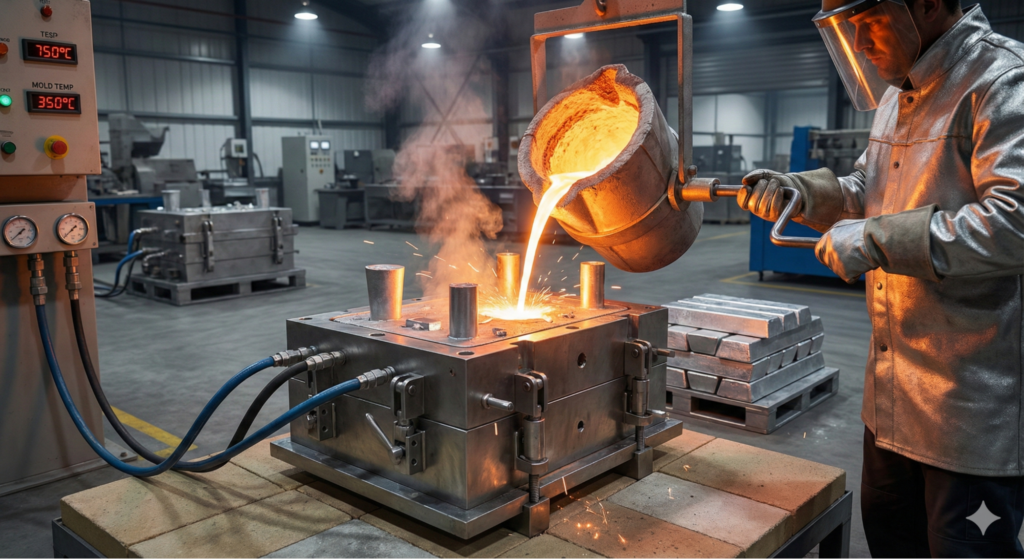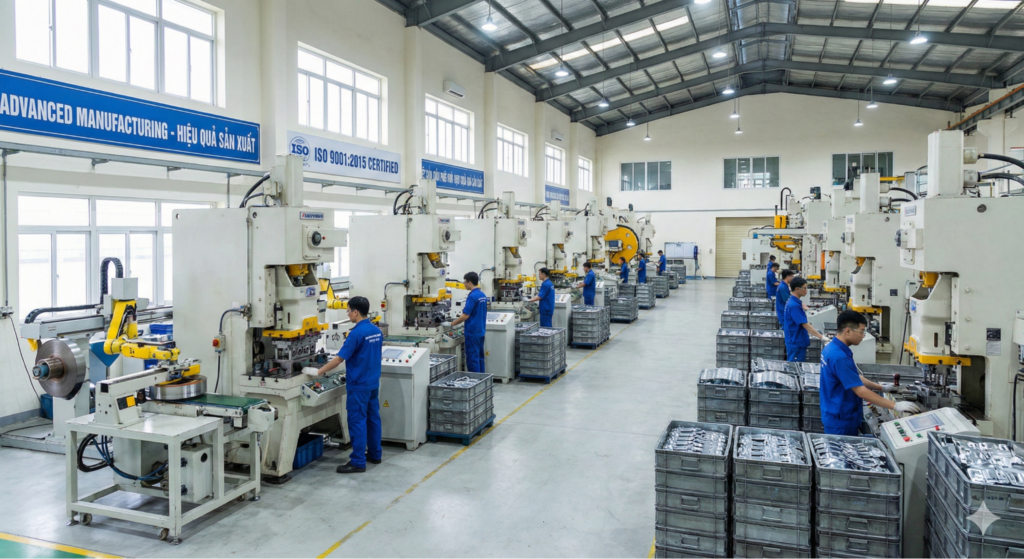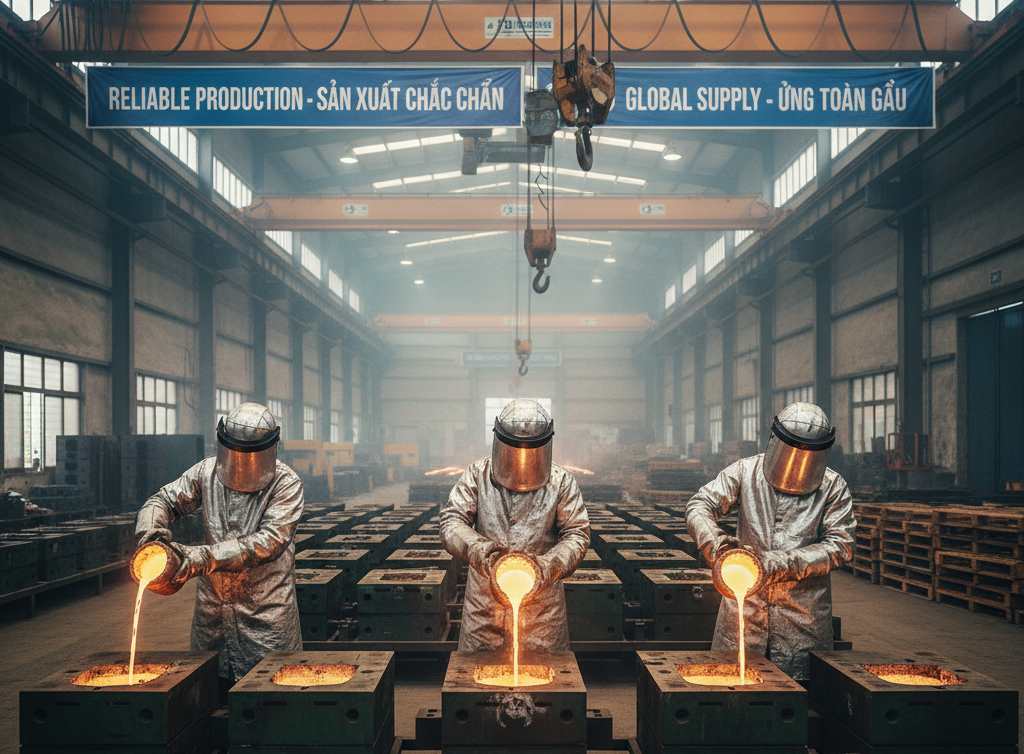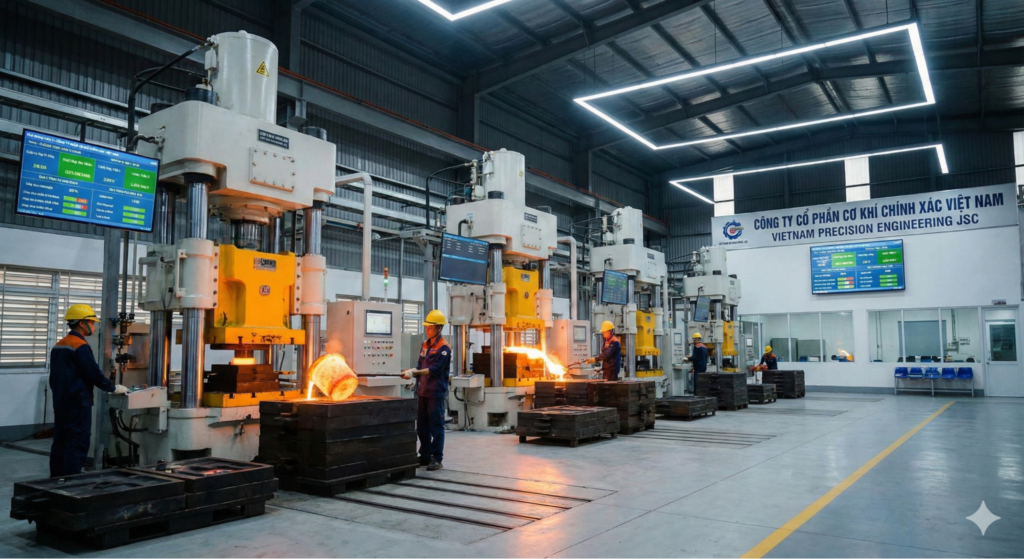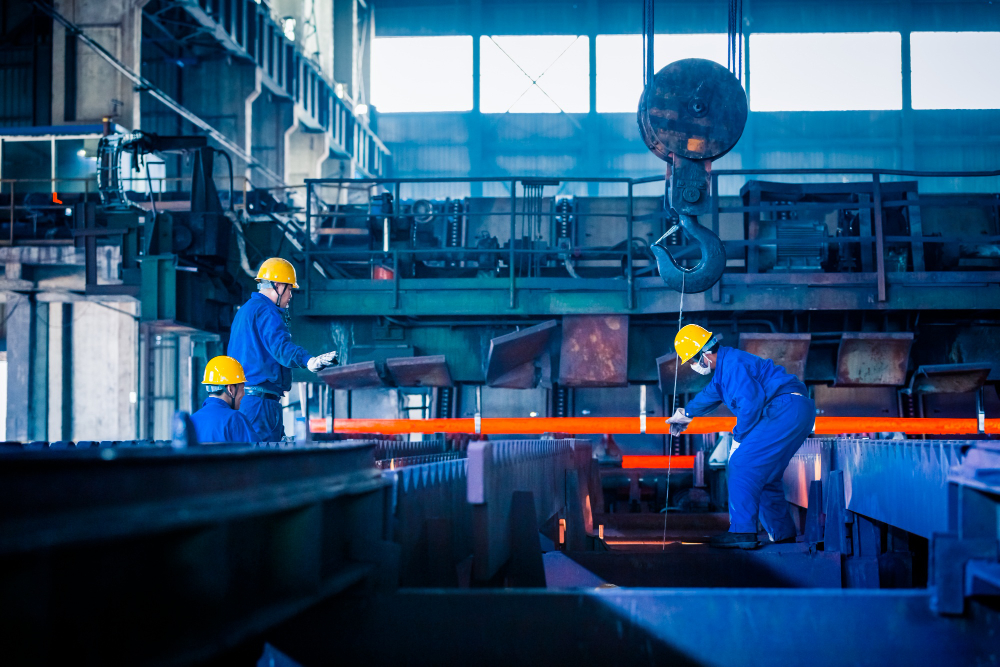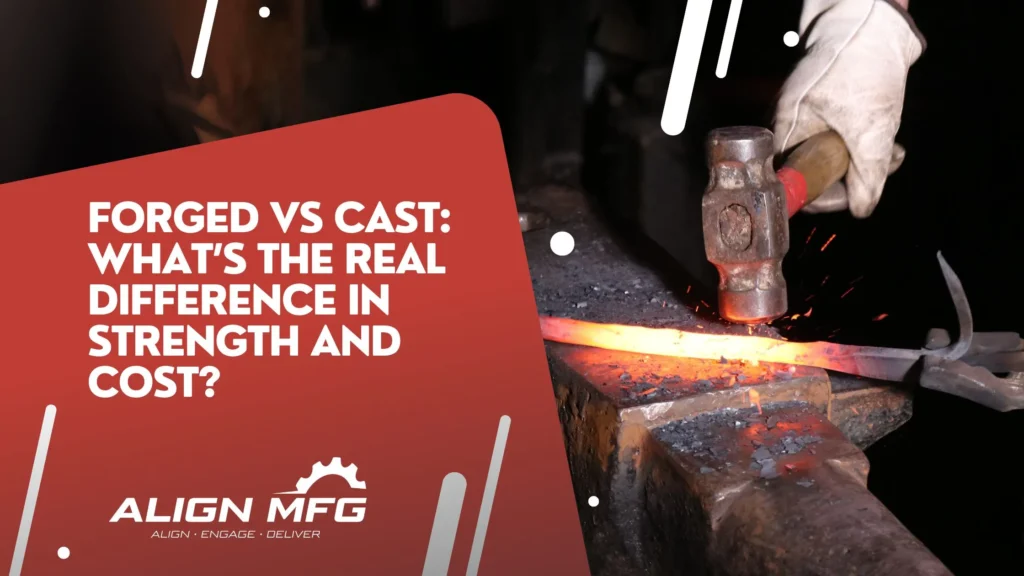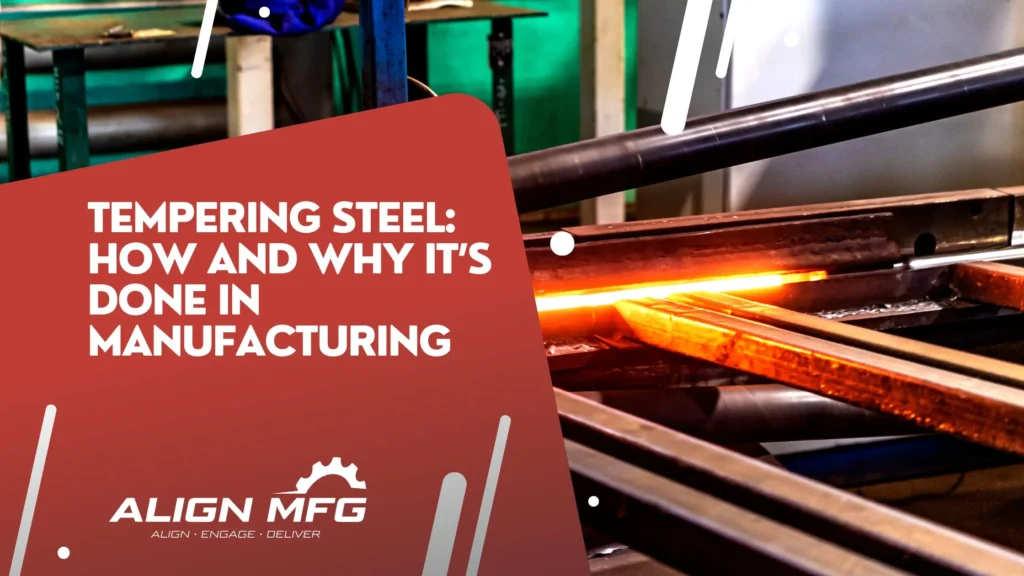Posts by Align Manufacturing
Why Vietnam Is a Hidden Gem for Gravity Casting
When companies look beyond traditional manufacturing hubs, they increasingly discover that Vietnam gravity casting offers a uniquely advantageous mix of cost, capability, and flexibility. As global demand grows for precision-cast metal parts, Vietnam is quietly emerging as a go-to destination. In this article, we explore why gravity casting in Vietnam deserves more attention than it currently gets.
Gravity casting (also called permanent mold casting) is a process where molten metal is poured into a reusable metal mold without external pressure. It sits between sand casting (lower tooling cost, rougher finish) and high-pressure die casting (higher tooling cost, highest throughput).
Core advantages include:
- Better mechanical properties than sand casting due to faster cooling in metal molds
- Improved surface finish and dimensional repeatability vs. sand casting
- Longer mold life and lower porosity than sand casting
- Lower capital/tooling cost and less porosity risk than high-pressure die casting for medium volumes
Why Vietnam for Gravity Casting?
1. Competitive Cost Structure Without Sacrificing Quality
Vietnam offers significantly lower labor and overhead costs while still maintaining dependable casting quality. Many foundries operate with international standards in mind, giving buyers an attractive combination of cost savings and consistent performance across a wide range of gravity-cast metal parts.
2. Skilled Workforce and Growing Industrial Expertise
The country’s casting sector has rapidly modernized, with foundries investing in better equipment, training, and process control. As a result, Vietnam now supports more complex and higher-tolerance gravity castings for industries like automotive, machinery, and heavy equipment.
3. Material Flexibility & Suitability for Medium-to-Large Castings
Vietnamese foundries handle a wide variety of alloys and specialize in gravity casting parts that benefit from strength, durability, and medium-to-large dimensions. This makes Vietnam well-suited for components such as housings, fittings, and industrial equipment parts that don’t require ultra-thin walls.
4. Strategic Export Location and Supply-Chain Accessibility
With strong logistics links and an export-oriented manufacturing base, Vietnam offers shorter lead times and simpler global shipping compared with more distant industrial hubs. Many gravity-casting suppliers already work with international buyers, making onboarding smoother and more predictable.
5. Modernizing Infrastructure and Increasing Capabilities
Vietnam’s foundry industry has shifted from small artisanal operations to facilities equipped with modern melting systems, improved molding technology, and integrated machining. This ongoing upgrade boosts reliability and expands the types of projects that can be supported locally.
Qualitative regional comparison (indicative)
| Factor | Vietnam | China | India | Thailand |
| Tooling Cost | Low–Medium | Medium | Low | Medium |
| Casting + Machining Cost | Low–Medium | Medium | Low–Medium | Medium |
| Quality Systems Maturity | High (growing) | High | Medium–High | High |
| Export Logistics | Strong | Strong | Medium | Strong |
| FTA Coverage | Broad | Broad | Broad | Broad |
Conclusion
For manufacturers seeking dependable, cost-efficient casting solutions, gravity casting Vietnam stands out as a powerful and often overlooked option. With improving capabilities, competitive pricing, and a globally connected industrial base, Vietnam is well-positioned to support high-quality gravity-cast components while strengthening supply-chain resilience. As sourcing strategies evolve, Vietnam’s gravity-casting sector offers the flexibility and value that modern manufacturing demands.
Strategic Benefits of Shifting Metal Stamping Production to Vietnam
As global manufacturing evolves, companies are increasingly seeking reliable, cost-efficient destinations for high-precision component production. Many businesses are now exploring metal stamping Vietnam as a strategic alternative to traditional manufacturing hubs, thanks to the country’s growing industrial capabilities, competitive pricing, and improving export infrastructure. This article explores why shifting your metal stamping production to Vietnam can strengthen your supply chain, enhance product quality, and reduce operational costs.
Vietnam’s Rising Role in Global Metal Stamping
Over the past decade, Vietnam has transformed into a competitive manufacturing base. Supported by foreign investment, industrial modernization, and trade agreements, the country now plays a growing role in supplying precision-engineered parts to sectors including automotive, electronics, industrial machinery, home appliances, and consumer goods.
Several factors have contributed to Vietnam’s rise:
- Improved manufacturing standards
- Advanced stamping machinery
- Skilled technical workforce
- Strong government incentives
Why Companies Are Shifting Metal Stamping to Vietnam
1. Significant Cost Advantages
Vietnam offers one of the most attractive cost structures in Asia. Companies benefit from competitive labor rates, lower facility overhead, and flexible production volumes. Tooling and die creation also tend to be more affordable compared to regional alternatives. Altogether, these advantages help manufacturers maintain high quality while improving margins (especially for large-volume parts such as brackets, chassis components, terminals, washers, and enclosures).
2. Quality Manufacturing with Modern Equipment
Metal stamping facilities in Vietnam have advanced quickly in both capability and technology. Many factories now operate high-speed presses, progressive die systems, automated feeders, and integrated CNC or laser-cutting support. In-house precision toolmaking strengthens quality control, while internationally recognized standards like ISO 9001, ISO 14001, and IATF 16949 ensure consistent, repeatable production across tight-tolerance parts.
3. Skilled Workforce at Competitive Rates
Vietnam’s workforce is young, technically trained, and experienced in industrial manufacturing. Machine operators and toolmakers are widely available, and QC technicians are trained to support demanding production requirements. Turnover rates are also lower relative to certain neighboring countries, giving companies long-term stability and smoother production planning.
4. Supply Chain Diversification and Risk Reduction
With global disruptions reshaping sourcing strategies, Vietnam has become a practical location for diversification. It offers a strong alternative to China, reduces exposure to tariff volatility, and provides access to a growing supplier network. Companies that shift part of their metal stamping portfolio to Vietnam often achieve a more resilient and balanced supply chain overall.
5. Extensive Trade Agreements for Global Exporting
Vietnam participates in major trade agreements (including CPTPP, EVFTA, and RCEP) which lower tariffs and streamline customs procedures. These policies help Vietnamese-manufactured stamped components become more cost-competitive across markets such as the U.S., EU, Japan, and Australia, strengthening the country’s global export advantage.
Additional Operational Advantages
Flexible MOQs and Production Volumes
Many Vietnamese suppliers support lower MOQs, scalable production, and adaptable batch sizes (ideal for pilot runs, prototyping, or high-volume growth).
Improved Lead Times and Logistics
With modern ports, upgraded freight routes, and industrial zones located near shipping hubs, Vietnam offers efficient transit times and reliable logistics.
Growing Eco-System for Secondary Processes
Powder coating, plating, welding, assembly, and packaging capabilities are increasingly available domestically, enabling end-to-end manufacturing in Vietnam.
What Types of Companies Benefit Most?
Shifting metal stamping production to Vietnam is especially valuable for companies producing:
- Automotive components
- Electrical and electronics parts
- Industrial machinery hardware
- Home appliance metal pieces
- Consumer product metal inserts or accessories
Key Considerations When Choosing a Vietnamese Stamping Partner
- Technical Capabilities: Evaluate stamping press tonnage, die types, automation, and precision equipment.
- Quality Systems: Look for ISO certifications, PPAP readiness, FAI reporting, and documented inspection controls.
- Tooling Capabilities: High-performing tools require in-house die design, machining, maintenance, and fast repair turnaround.
- Communication & Project Management: Reliable suppliers offer structured communication, technical collaboration, and clear milestone tracking.
Conclusion
Shifting metal stamping operations to Vietnam provides companies with a powerful combination of cost savings, improved supply chain resilience, high-quality manufacturing, and access to a skilled workforce. As production capabilities continue to expand, metal stamping Vietnam is becoming one of the most strategic choices for manufacturers seeking reliable, scalable, and cost-effective stamping solutions. For businesses planning long-term growth and competitive advantage, Vietnam offers an ideal foundation for both diversification and sustained operational success.
Reducing Supply-Chain Risk with Sand Casting in Vietnam
Global supply chains are under pressure from geopolitical shifts, rising freight costs, and changing customer expectations. For manufacturers seeking resilient, cost-effective production outside traditional hubs, sand casting Vietnam offers a compelling combination of capacity, flexibility, and proximity to key Asian markets. When deployed strategically, Vietnam-based sand casting can reduce lead-time risk, diversify supplier exposure, and maintain consistent quality for critical components.
Why supply-chain risk is rising (and what it costs you)
Over the last decade, manufacturers have learned the hard way that lean, single-source strategies are fragile. Common sources of disruption include:
- Geopolitical and trade volatility: Tariffs, trade restrictions, and diplomatic tensions can suddenly raise costs or close routes
- Logistics shocks: Port congestion, container shortages, and airline capacity limits increase transit times and variability
- Concentration risk: Relying on a small number of suppliers or a single country for critical parts magnifies the impact of any local disruption
- Quality and compliance gaps: Inconsistent standards across suppliers cause rework, delays, and warranty exposure
- Labor and capacity fluctuations: Sudden labor disputes or pandemic-related shutdowns can halt production for weeks
Mitigating these risks requires both strategic rebalancing (diversifying where you source) and tactical process controls (how you qualify, monitor, and manage suppliers).
How sand casting in Vietnam reduces risk
1. Geographical diversification and proximity to major markets
Shifting a portion of sand casting capacity to Vietnam reduces reliance on any single country or supplier. Vietnam’s location provides faster access to Asian supply hubs (China, Japan, Korea), and competitive transit options to Europe and North America compared with purely overseas alternatives. This lowers the transit time risk and enables faster response to demand spikes.
2. Competitive and stable production costs
Vietnam’s labor and operating costs remain attractive compared with many developed markets. For cost-sensitive cast components (brackets, housings, pump bodies, engine components) these savings help protect margins during inflationary periods and can be reinvested into quality controls or inventory buffers.
3. Expanding industrial capacity and skilled labor
Over the past decade, Vietnam’s metalworking and foundry sectors have matured, producing a growing pool of skilled technicians experienced with sand casting, machining, and finishing. This improves the likelihood of consistent part quality and reduces the technical ramp-up time for new programs.
4. Supplier ecosystem and tooling flexibility
Vietnam hosts many small-to-medium foundries that can handle low- to mid-volume runs and rapid tooling changes. This is ideal for products with iterative design cycles or modest batch sizes. Working with multiple vetted foundries in-country enables quick ramp-up if demand shifts or one supplier faces a disruption.
5. Stronger control through local oversight
Shorter distances and relatively affordable travel mean more frequent in-person audits, qualification visits, and joint problem-solving sessions. Localized oversight reduces the intelligence gap and accelerates corrective actions when issues arise.
6. Compliance and certification capability
Many Vietnamese foundries now pursue international certifications (ISO, IATF, etc.) and export-ready processes. Partnering with certified suppliers reduces regulatory risk and helps ensure parts meet safety and performance specifications for regulated markets.
Practical strategies for leveraging sand casting with minimal risk
Supplier selection & dual-sourcing
Qualify at least two suppliers for critical castings, one in Vietnam and another in a different region. Dual-sourcing reduces single-point failure and creates natural competition that helps maintain cost and quality.
Robust qualification and inspection plans
Define clear incoming inspection criteria (dimensional, metallurgical, and non-destructive testing where appropriate). Use first-article inspections, statistical process control, and agreed corrective action timelines.
Tooling strategy and design-for-manufacture
Design castings with manufacturability in mind: avoid overly complex cores or sections that create hot spots. When tooling is required, consider splitting tooling investments across suppliers or using modular tooling to reduce time-to-switch.
Lead-time and inventory optimization
Balance just-in-time ambitions with strategic buffers for high-risk SKUs. Leverage shorter regional lead times from Vietnam to reduce costly emergency air shipments while maintaining lower on-hand inventory.
Technology and data integration
Use digital order tracking, cloud-based quality records, and inline process sensors where possible. Real-time visibility into production status and QC data enables faster decisions and earlier problem detection.
Local representation and continuous improvement
Maintain a local point of contact (either internal or through a trusted partner) to manage day-to-day supplier relations, expedite issues, and drive continuous improvement projects.
Conclusion
Adding Vietnam sand casting to a global sourcing strategy can significantly reduce supply-chain risk by diversifying geographic exposure, lowering cost volatility, and enabling faster, more flexible production near Asia-Pacific markets. With rigorous supplier qualification, strong inspection programs, and the right tooling and logistics strategy, manufacturers can capture the resilience benefits without sacrificing quality or predictability. If you’re evaluating options to strengthen your casting supply chain, consider Vietnam as a strategic, pragmatic choice.
A Complete Guide to Sourcing Forged Components from Vietnam
Forged components are a cornerstone of modern manufacturing, providing strength, durability, and precision for industries ranging from automotive to aerospace. As global demand grows, manufacturers are increasingly exploring forging Vietnam as a cost-effective and reliable sourcing option. This guide covers everything you need to know about sourcing forged components from Vietnam, including the benefits, key considerations, and best practices to ensure high-quality, reliable supply.
Why Vietnam Is Emerging as a Forging Hub
Vietnam has rapidly transformed its industrial landscape in the last decade. Favorable government policies, a growing skilled workforce, and investment in modern manufacturing infrastructure have made it a competitive alternative to traditional suppliers in China and India. Key reasons to consider Vietnam include:
- Cost-Effective Manufacturing: Labor costs in Vietnam remain lower than in many developed countries, offering significant savings without compromising on quality
- Strategic Location: Vietnam’s proximity to major shipping routes in Southeast Asia ensures efficient logistics and reduced lead times
- Skilled Workforce: The country has a rapidly growing pool of trained engineers and technicians experienced in forging and metalworking
- Investment in Technology: Vietnamese manufacturers are increasingly adopting CNC machining, precision forging presses, and quality control systems that meet international standards
Understanding Forged Components

Forging is a manufacturing process in which metal is shaped using compressive forces, often at high temperatures. Unlike casting or machining from solid stock, forging aligns the internal grain of the metal, improving strength, durability, and fatigue resistance. Common forged components include:
- Automotive parts such as crankshafts, gears, and connecting rods
- Aerospace components like turbine shafts and landing gear parts
- Industrial machinery components including valves, couplings, and heavy-duty fasteners
Vietnamese suppliers specialize in a range of forging methods, including open-die forging, closed-die forging, and hot/cold forging, catering to diverse industrial requirements.
Benefits of Sourcing Forged Components from Vietnam
1. High Quality at Competitive Prices
Vietnamese forging companies often provide components that meet international standards such as ISO 9001 and IATF 16949. By leveraging cost-efficient labor and modern facilities, suppliers can offer competitive pricing without compromising on quality.
2. Flexibility in Order Volume
Whether you require small batches for prototyping or large-scale production runs, Vietnamese manufacturers can accommodate various order sizes. Many suppliers also offer customization, allowing for unique dimensions, tolerances, and surface finishes.
3. Reduced Lead Times
With shorter shipping distances within Asia and strong domestic manufacturing capabilities, sourcing from Vietnam can reduce lead times compared to suppliers in Europe or North America.
4. Strong Export Infrastructure
Vietnam has developed a robust export infrastructure, including ports, logistics providers, and free trade agreements with countries such as the EU and the US, facilitating smoother international transactions.
How to Select the Right Supplier
Choosing the right forging supplier is crucial to ensure product quality, timely delivery, and cost-effectiveness. Key factors to evaluate include:
Certification and Compliance
Verify that the supplier adheres to international quality standards such as ISO 9001, IATF 16949, or specific aerospace certifications if applicable. These certifications indicate a commitment to quality control and process consistency.
Technical Capabilities
Assess whether the supplier has the necessary forging technology to meet your specifications. For example, high-strength steel components may require closed-die forging and advanced heat treatment processes.
Production Capacity
Ensure the supplier can handle your order volume, both for initial orders and potential scaling in the future. Understanding their production capacity prevents delays and ensures consistent supply.
Track Record and References
Request case studies or references from other clients in your industry. A proven track record with similar components provides confidence in the supplier’s reliability.
Communication and Support
Effective communication is vital, especially for complex components. Choose a supplier who is responsive, transparent, and capable of providing technical support during design, prototyping, and production phases.
Common Challenges and How to Overcome Them
- Language and Cultural Barriers: While English is commonly used in business, differences in communication styles can create misunderstandings. Clear documentation, visual aids, and frequent check-ins help bridge this gap
- Quality Consistency: Some smaller manufacturers may struggle with consistent quality. Mitigate this risk by choosing certified suppliers, conducting audits, and specifying rigorous quality control procedures
- Regulatory Compliance: Ensure that imported components comply with your country’s safety and regulatory standards. Partnering with suppliers experienced in international export reduces potential compliance issues
Conclusion
Forging Vietnam offers manufacturers a strategic opportunity to access high-quality, cost-effective forged components with flexibility in production and shorter lead times. By carefully selecting suppliers, clearly defining specifications, and implementing quality assurance practices, companies can successfully integrate Vietnamese forged components into their supply chain. For manufacturers looking to optimize procurement and ensure reliable supply, forging Vietnam is a smart and efficient choice that balances quality, cost, and operational efficiency.
High-Pressure Die Casting in Vietnam: Future Trends to Watch
High-pressure die casting (HPDC) has been the backbone of modern manufacturing for decades, producing everything from automotive housings and engine components to consumer electronics frames and intricate industrial parts. But the process, while mature, is far from static. Around the world and especially in Vietnam, high-pressure die casting is undergoing a major transformation, driven by evolving customer demands, rapid advances in technology, and a new focus on sustainability and efficiency.
This article breaks down the key technologies, trends, and strategies shaping the future of die casting, and how partnering with the right supplier can give your business a decisive edge.
Why High-Pressure Die Casting is Changing
The basic principles of HPDC remain the same: molten metal (usually aluminum, zinc, or magnesium) is injected under high pressure into a steel mold to produce complex, dimensionally precise parts at scale. But the global manufacturing landscape around it has shifted dramatically in the past few years.
Several key factors are driving innovation in HPDC:
- Lightweighting and performance. Automotive, EV, and aerospace sectors demand lighter components without compromising strength.
- Sustainability. Global customers and regulators are pushing for greener processes, less waste, and lower energy consumption.
- Digitalization. Industry 4.0 technologies (sensors, data analytics, and digital twins) are reshaping how factories operate.
- Cost and speed pressures. Shorter development cycles, higher quality expectations, and global competition mean manufacturers must deliver more, faster.
1. Digital Twin Technology and Simulation-Driven Design
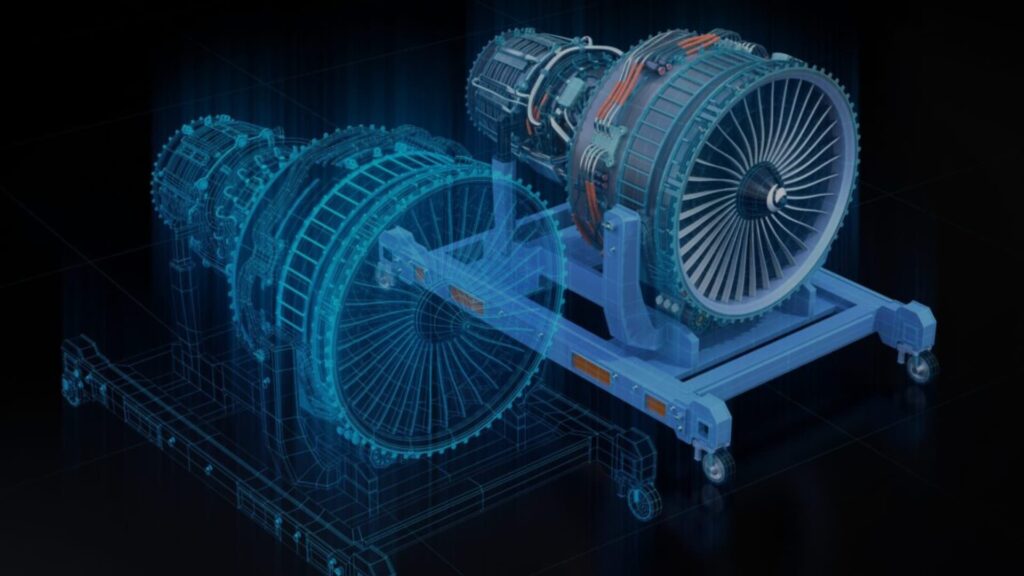
One major advancement in die casting is the use of digital twin technology, virtual models that simulate real casting processes. With advanced software, engineers can predict defects, test tooling, and optimize designs before building physical molds. This helps catch issues like porosity or warpage early, reducing trial and error, speeding up development, and cutting costs.
In Vietnam, more die casting suppliers are investing in these powerful simulation tools, which enable closer collaboration with clients right from the design phase. The result is not only higher-quality parts but also smoother development cycles, shorter lead times, and reduced project risks.
2. Smart Factories, Automation, and Robotics
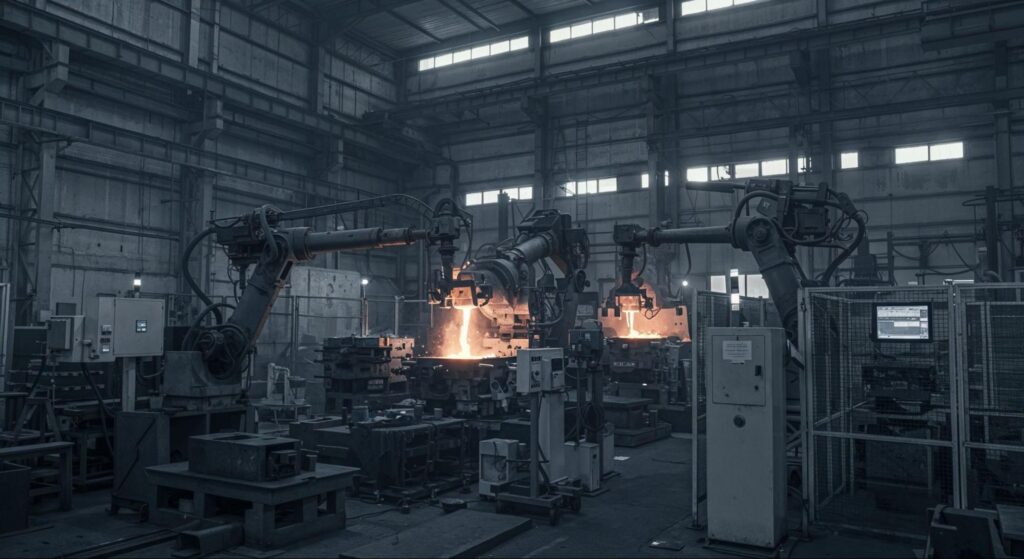
Automation is now essential in high-pressure die casting. Modern lines use robotics for metal feeding, spraying, part removal, trimming, and quality checks, while sensor-driven controls boost precision. This leads to better quality, faster cycle times, and safer operations.
In Vietnam, die casting facilities are quickly embracing these technologies, often using advanced European or Japanese equipment. As a result, manufacturers sourcing parts from Vietnam can now access world-class quality, high scalability, and competitive lead times, all while benefiting from significantly lower costs compared to traditional die casting hubs like China or Germany.
3. Advanced Alloys and Lightweight Materials
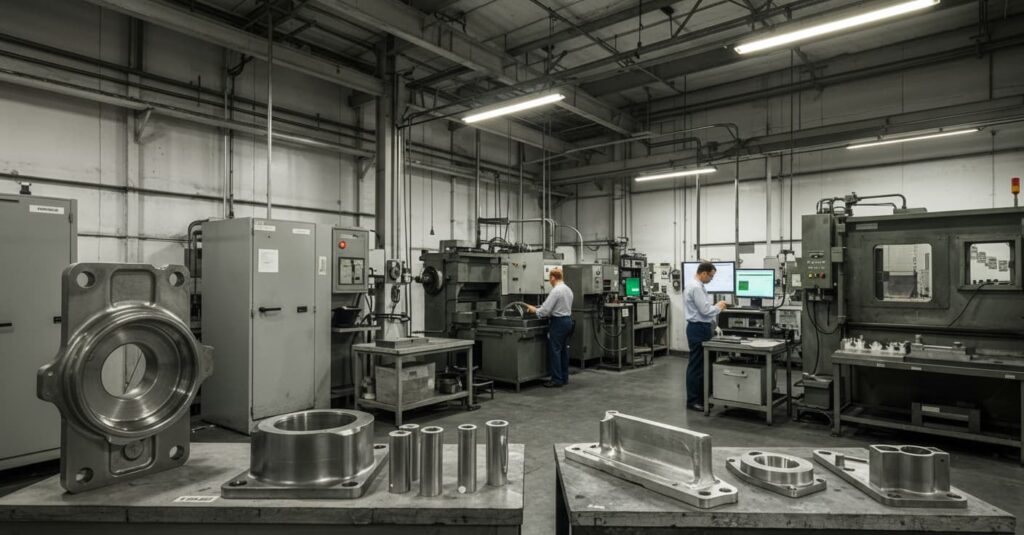
Material science is increasingly shaping die casting as industries seek stronger, lighter, and more durable parts. New aluminum, zinc, and magnesium alloys deliver improved performance, from lightweight magnesium for EVs and aerospace to high-strength aluminum for thin, strong components and custom blends tailored to specific needs.
In Vietnam, suppliers that once focused mainly on standard alloys like A380 and ADC12 are now expanding their capabilities to include these advanced materials. This shift is empowering manufacturers to create next-generation components locally. Combining innovation, performance, and cost efficiency in a single sourcing destination.
4. Smarter Surface Finishing and Post-Processing
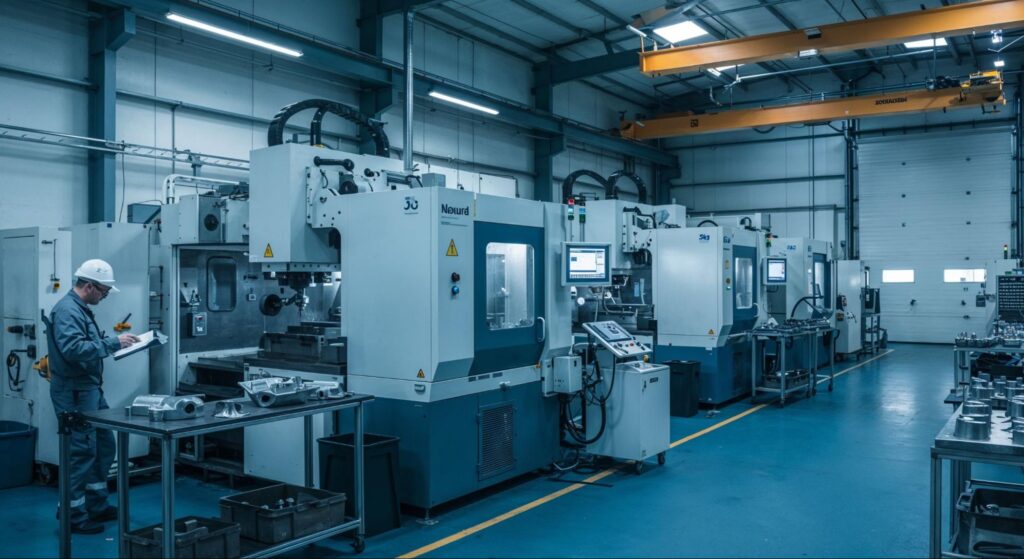
Casting is only half the story. Finishing determines how a part performs and looks. Modern post-processing like automated deburring, polishing, anodizing, and specialty coatings improves quality, cuts costs, and achieves tighter tolerances.
For buyers, these innovations mean fewer secondary suppliers, lower logistics costs, and faster delivery of ready-to-use components. In Vietnam, many die casting facilities now provide turnkey solutions (offering everything from casting to coating under one roof) making sourcing simpler, faster, and more cost-effective.
5. Real-Time Monitoring and Data Analytics
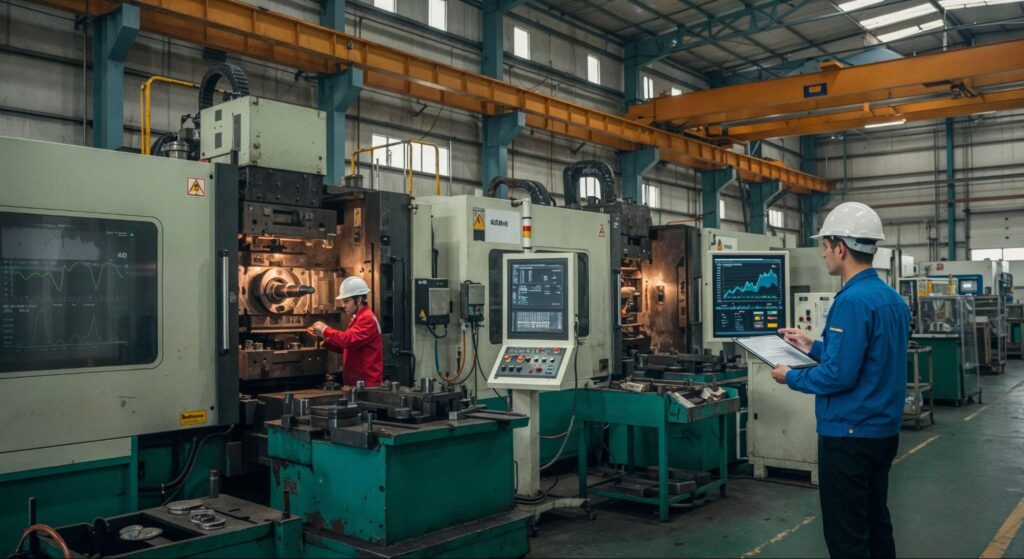
One of the most transformative shifts in high-pressure die casting in Vietnam is the adoption of real-time process monitoring and data analytics. Many local facilities now embed sensors in machines to track cavity pressure, mold and melt temperature, cooling rates, and injection speed. This data is analyzed to detect deviations, prevent defects, and even predict maintenance needs before downtime occurs.
The result is higher yields, more consistent quality, and improved production insight. For international buyers sourcing from Vietnam, these technologies provide greater traceability and confidence, ensuring that locally produced parts meet strict global standards reliably and efficiently.
The Future Of Die Casting in Vietnam
The next five years will redefine what’s possible in die casting, and Vietnam is poised to lead that evolution. As the industry embraces innovations in high pressure die casting Vietnam, manufacturers are focusing on greater precision, automation, and performance efficiency. We’re entering a new era where data-driven manufacturing, sustainability, and advanced materials are as important as cost and capacity. At AlignMFG, we combine advanced high-pressure die casting capabilities with cutting-edge technology, world-class quality control, and a customer-first approach. Whether you’re designing next-generation EV components, lightweight industrial enclosures, or high-precision consumer products, our team in Vietnam can help you bring your project to life.
How to Choose the Right Fabrication Partner in Vietnam
If you’ve been keeping an eye on global manufacturing trends, you’ve probably noticed one country making waves in the fabrication industry: Vietnam. Once considered a secondary player to giants like China or India, Vietnam has rapidly become a go-to destination for companies looking to outsource metal fabrication, welding, laser cutting, and CNC machining.
Choosing the right partner is critical if you want quality, consistency, cost-efficiency, and risk mitigation. In this guide, we’ll walk you through everything you need to know to confidently choose a fabrication partner in Vietnam, from what to look for and questions to ask, to pitfalls to avoid.
Why Vietnam Is Becoming a Fabrication Hotspot
- Cost Advantages Without Cutting Corners
Vietnam offers lower labor and operating costs compared to many traditional manufacturing hubs. This often translates to 20–40% cost savings without sacrificing quality, a big win for companies trying to stay competitive.
2) Skilled Workforce and Modern Capabilities
Fabrication in Vietnam has come a long way. Today, you’ll find suppliers with advanced capabilities like laser cutting, robotic welding, CNC machining, bending, and assembly, often matching the standards of factories in more established markets.
3) Strategic Trade Agreements and Location
Vietnam is part of multiple trade deals (like CPTPP and EVFTA) and strategically located near major shipping routes. This means easier access to key markets like the U.S., Europe, and Japan, often with lower tariffs and shorter transit times.
4) Diversification and Supply Chain Resilience
With many companies adopting a “China + 1” sourcing strategy, Vietnam is a natural choice to diversify risk and build more resilient supply chains.
What to Look for in a Fabrication Partner in Vietnam
Capabilities That Match Your Needs
Start by understanding what services the supplier actually offers. A good fabrication partner should provide a range of processes so you don’t have to juggle multiple vendors. Look for capabilities like:
- Laser cutting and bending
- Welding and assembly
- CNC machining (3-, 4-, or 5-axis)
- Surface finishing (painting, coating, polishing)
- Prototyping and low-volume runs
- Final assembly and packaging
Quality Control and Certifications
Quality can make or break your product. Before committing, dig into how your potential partner manages quality. Look for:
- ISO 9001 certification (quality management)
- ISO 14001 (environmental management)
- Industry-specific standards (e.g., AWS for welding, ASME for pressure vessels)
- In-house inspection tools like CMM machines, material testing labs, and NDT capabilities
Proven Track Record
Experience matters. A supplier that’s already produced for your industry will better understand your needs, from tolerance requirements to compliance standards.
Look for signs of credibility:
- Case studies or client success stories
- References you can contact
- Years in operation and size of facility
- Export experience (especially to your target market)
Capacity and Scalability
One common mistake is choosing a partner that’s perfect for today’s order but can’t scale when you grow. If your product is likely to grow in volume, make sure the supplier is ready to grow with you. Ask about:
- Current production capacity and utilization
- Lead times for prototypes, small batches, and large orders
- Ability to add shifts or expand production if needed
Communication and Project Management
Even the most technically capable fabricator can cause problems if communication is poor. Clear, timely communication is crucial especially if you’re managing projects from overseas.
Ask these questions early:
- Do they have English-speaking engineers or project managers?
- How often will they provide updates (weekly reports, milestone check-ins)?
- Can they work directly from your CAD files and technical drawings?
Cost Transparency
Cost isn’t just about the price per part. The best suppliers will give you a clear breakdown of what’s included in the quote:
- Material costs
- Tooling/setup fees
- Labor and machining time
- Surface finishing
- Packaging and logistics
Transparent pricing helps you avoid unpleasant surprises later and makes it easier to compare quotes from multiple suppliers.
Intellectual Property (IP) Protection
Your designs are valuable. Before sharing CAD files or prototypes, make sure your partner takes IP protection seriously. Here’s how to reduce risk:
- Sign a Non-Disclosure Agreement (NDA) before sharing any technical data.
- Clearly outline IP ownership in your contract.
- Ask if they’ve worked with clients who have strict IP requirements.
Pitfalls to Avoid When Choosing a Fabrication Partner
Even experienced sourcing managers sometimes make these mistakes. Avoid them to save yourself headaches later:
- Choosing on price alone. A cheap quote can cost more in the long run if quality or reliability suffers.
- Skipping due diligence. Always check certifications, visit the factory if possible, and ask for references.
- Vague contracts. Clearly define quality expectations, tolerances, delivery schedules, and penalties in writing.
- Underestimating communication needs. Misunderstandings can cause costly delays. Make sure your supplier is responsive and aligned with your processes.
Conclusion
Choosing a fabrication partner in Vietnam is one of the most impactful decisions you’ll make for your product’s success. It’s not just about cost savings. It’s about building a partnership that supports your growth, protects your reputation, and ensures your customers get the quality they expect.
If you’re exploring fabrication in Vietnam, companies like Align Manufacturing can help make the process smoother. With capabilities that include welding and assembly, laser cutting, bending, and precision CNC machining, Align offers end-to-end fabrication solutions tailored to your needs.And if you’re ready to explore fabrication in Vietnam with a partner who ticks all those boxes, Align Manufacturing is a great place to start.
Investment Casting in Vietnam: Process & Benefits
Investment casting, also known as lost-wax casting, is a versatile, cost-effective method for producing complex, high-precision metal components across industries like aerospace, automotive, medical, and industrial machinery. As companies look for reliable alternatives to traditional manufacturing hubs, Vietnam is emerging as a top destination, offering competitive costs, skilled labor, and modern capabilities. This guide explains how investment casting works, why it’s widely used, and why Vietnam is ideal for your next project.
What Is Investment Casting?
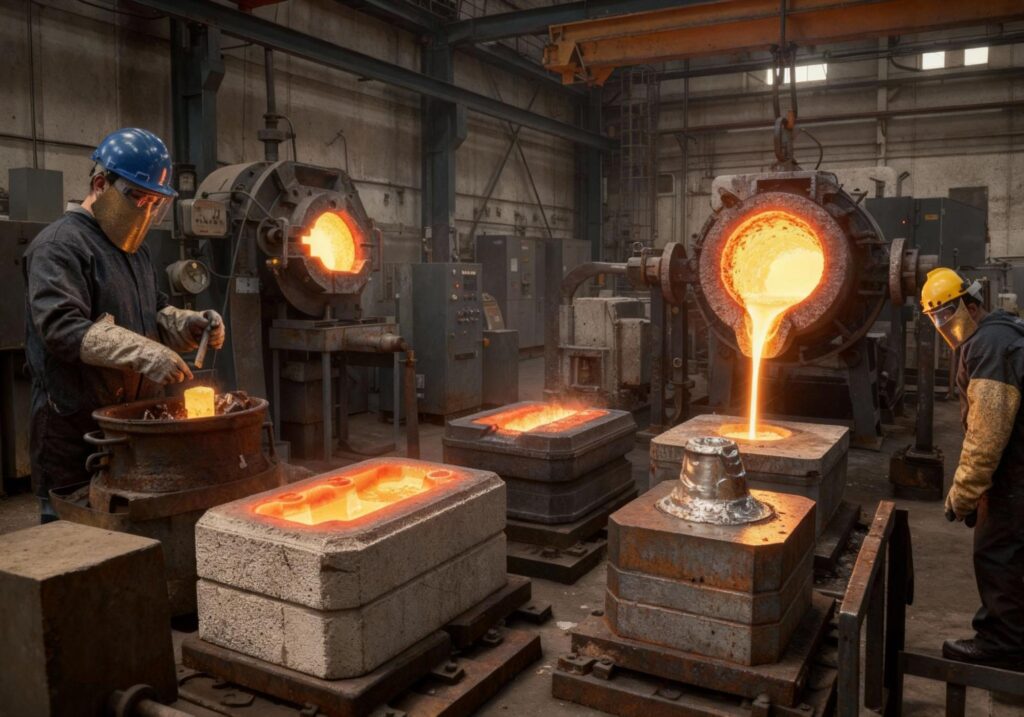
Investment casting is a precision metal-forming process that uses a wax pattern to create a ceramic mold, into which molten metal is poured to produce complex parts with excellent surface finish and tight tolerances. Because the mold is destroyed after each casting, the process is ideal for intricate geometries, thin walls, and near-net-shape components that would be difficult or expensive to machine.
Step-by-Step: How the Investment Casting Process Works
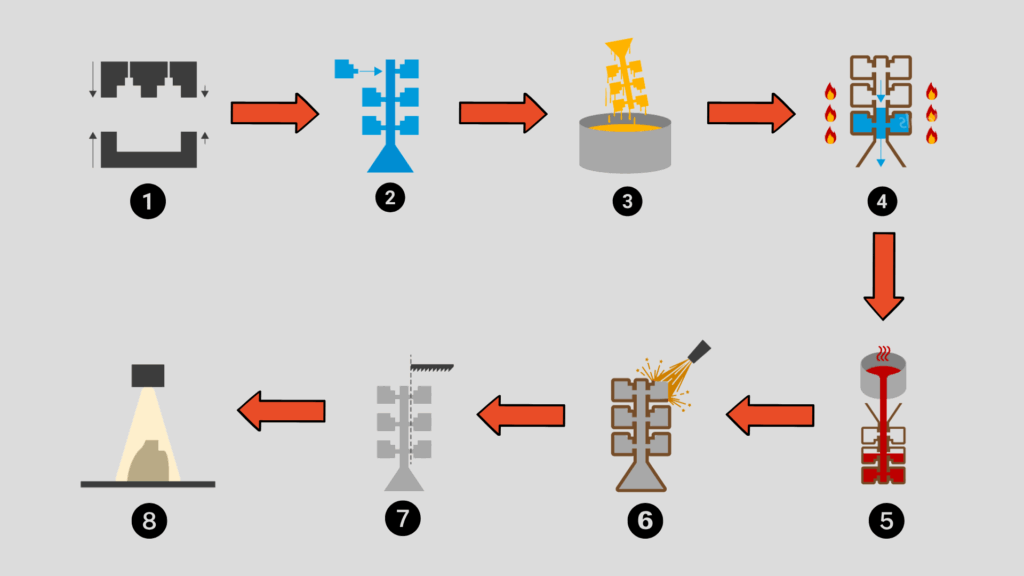
1. Wax Pattern Creation
The process starts with creating a wax replica of the final part. This pattern is typically made by injecting molten wax into a metal die. If the part is complex, multiple wax sections are assembled together.
2. Assembly (Treeing)
Multiple wax patterns can be attached to a central wax sprue, forming what’s known as a “tree.” This allows multiple components to be cast in a single batch, improving efficiency.
3. Ceramic Shell Building
The wax tree is repeatedly dipped into a ceramic slurry and coated with fine sand. After each layer dries, the process is repeated several times to build a strong ceramic shell capable of withstanding high casting temperatures.
4. Dewaxing
Once the ceramic shell is complete, the wax is melted and drained out, leaving a hollow mold cavity that precisely mirrors the original part geometry.
5. Metal Pouring
The preheated ceramic mold is filled with molten metal under carefully controlled conditions. The choice of alloy depends on the application, ranging from stainless steel and carbon steel to cobalt- or nickel-based superalloys.
6. Cooling and Shell Removal
After the metal solidifies, the ceramic shell is broken away, revealing the raw cast part.
7. Cutting, Finishing & Inspection
Individual castings are cut from the tree and undergo finishing processes like grinding, machining, heat treatment, and surface finishing.
8. Inspection
Rigorous inspections (including dimensional checks, NDT, and chemical analysis) ensure the final components meet all specifications.
Why Choose Investment Casting?
- Complex Geometry & Design Freedom
Because the wax pattern can replicate almost any shape, investment casting allows for intricate designs with fine details, thin walls, undercuts, and internal cavities without expensive tooling changes.
- Superior Surface Finish
The ceramic mold delivers a smooth surface straight out of the casting process, significantly reducing or even eliminating secondary machining and polishing.
- Material Versatility
Investment casting supports a wide range of metals and alloys (stainless steel, aluminum, titanium, cobalt-chrome, and more) enabling engineers to meet demanding performance and environmental requirements.
Why Vietnam Is Becoming a Top Choice for Investment Casting
1) Cost-Effective Manufacturing
Vietnam’s lower labor costs, often 30–50% below China, translate into highly competitive pricing without compromising quality. Combined with efficient operations and favorable logistics, buyers often achieve significant cost savings per unit.
2) Skilled Workforce & Industrial Growth
Vietnam’s rapid industrialization has been accompanied by a focus on technical training and manufacturing excellence. Many foundries now operate with modern equipment, ISO certifications, and experienced engineering teams.
3) Strategic Location & Trade Advantages
With free trade agreements like the CPTPP and EVFTA, Vietnam enjoys preferential access to major markets in the U.S., EU, and Asia. Its proximity to global supply chain hubs also reduces shipping times and logistics costs.
4) Advanced Capabilities
Vietnamese foundries have invested heavily in advanced casting technology, from 3D-printed wax patterns to automated shell building, enabling them to produce high-precision components for demanding industries.
5) Flexible Production Volumes
From low-volume prototype runs to high-volume production, investment casting facilities in Vietnam offer scalability that suits both startups and global OEMs.
Industries That Rely on Investment Casting in Vietnam
- Aerospace: Turbine blades, brackets, housings
- Automotive: Turbocharger components, suspension parts
- Energy: Pump bodies, valve components, impellers
- Medical: Surgical instruments, implantable components
- Industrial Equipment: Tooling, wear-resistant parts, machine housings
Conclusion
Investment casting remains one of the most powerful manufacturing methods for producing high-quality metal components with precision and design flexibility. As companies rethink their sourcing strategies in a globalized landscape, Vietnam stands out as a smart, strategic choice, combining cost advantages with technical expertise, modern facilities, and strong quality standards.Ready to explore investment casting solutions in Vietnam? Align Manufacturing’s engineering team can support your project from concept to completion, helping you bring high-quality, cost-effective components to market faster.
Why Vietnam is Emerging as a CNC Precision Machining Hub
CNC precision machining plays a vital role in global manufacturing, powering sectors from aerospace and automotive to medical devices and consumer electronics. While leaders like China, Japan, and Germany continue to dominate, Vietnam is steadily expanding its capabilities. As industries look to balance cost, quality, and flexibility, many consider how Vietnam precision machining suppliers fit into the broader Southeast Asian manufacturing landscape.
Once viewed mainly as a low-cost assembly base, Vietnam now blends competitive pricing with technical proficiency and growing innovation capacity.
What Is CNC Precision Machining?
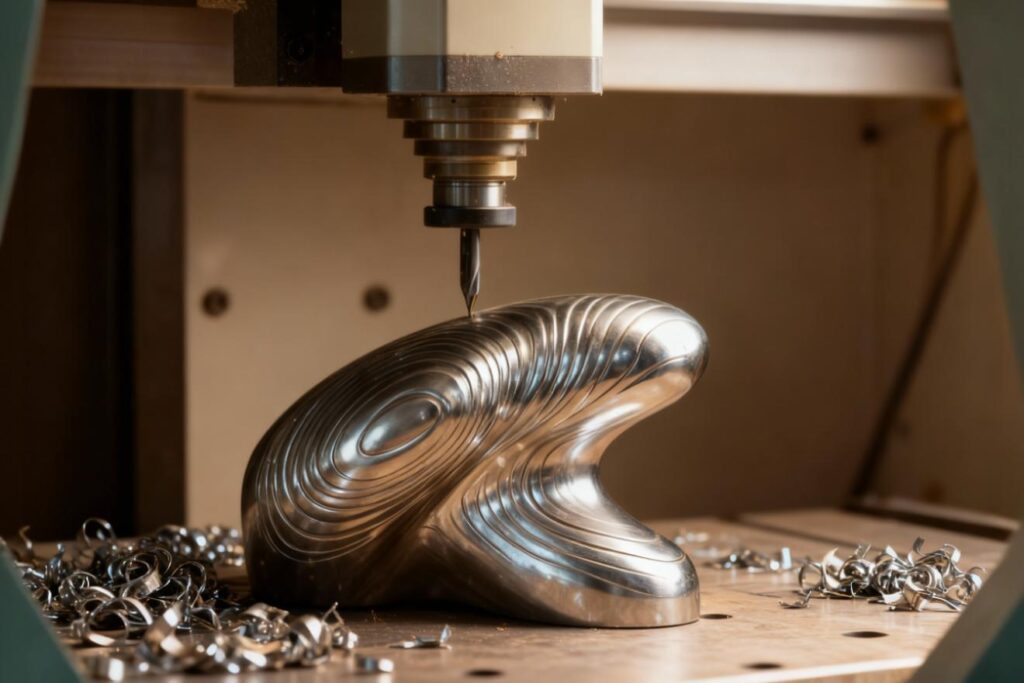
CNC (Computer Numerical Control) machining is an automated manufacturing process that uses computer-controlled tools to shape raw materials like metals or plastics, into precise, complex parts. It’s ideal for creating both prototypes and full-scale production parts.
Because CNC machining combines speed, accuracy, and versatility, it’s ideal for producing parts used in industries where reliability and performance are non-negotiable like automotive, aerospace, oil & gas, robotics, and consumer electronics.
Why Vietnam Is Becoming a Global CNC Destination
1. Competitive Costs Without Compromising Quality
Vietnam offers significantly lower labor and facility costs compared to China, Japan, or Western countries, while still maintaining a high standard of output. Skilled machinists are able to deliver precise, high-quality components without the premium costs often associated with other manufacturing hubs. Additionally, shorter supply chains and regional access to raw materials help reduce logistics expenses, further improving cost efficiency.
2. Rapidly Growing Skilled Workforce
One of Vietnam’s strongest advantages lies in its rapidly expanding pool of skilled workers. Technical schools and vocational training programs across the country are producing engineers and machinists who are proficient in CAD/CAM design and CNC programming. This growing talent base is complemented by hands-on experience with international quality standards, ensuring that Vietnamese manufacturers can deliver complex, precision-engineered projects with consistency and reliability.
3. Modern Facilities and Advanced Equipment
Vietnamese machining facilities are investing heavily in state-of-the-art technology. Many workshops are now equipped with 3-, 4-, and 5-axis CNC machining centers capable of handling highly complex geometries. Advanced quality control systems, including CMMs and optical inspection tools, are increasingly common, allowing manufacturers to maintain tight tolerances and ensure product accuracy. The adoption of smart manufacturing practices also boosts efficiency, reduces errors, and shortens lead times.
4. Business-Friendly Environment and Trade Advantages
Vietnam’s government has created a highly supportive business environment that encourages foreign partnerships and investment. Tax incentives, well-planned industrial zones, and simplified regulations make it easier for companies to set up and scale operations. In addition, Vietnam’s participation in key trade agreements, such as the CPTPP and EVFTA, lowers tariffs and simplifies market entry for global customers, giving manufacturers and clients a clear competitive edge.
5. Strategic Location in Southeast Asia
Vietnam’s geographic position is another factor behind its growing appeal. Its proximity to material suppliers and tooling manufacturers helps reduce procurement times, while access to major shipping routes ensures fast and cost-effective global exports. Moreover, Vietnam’s location makes it an ideal hub for companies operating multi-country supply chains across Asia, offering both logistical convenience and strategic reach.
Vietnam vs. China: How Do They Compare?
| Feature | China | Vietnam |
| Labor cost | Rising | Lower, stable |
| Machine technology | Mature | Rapidly modernizing |
| Supply chain depth | Very deep | Growing fast |
| Political/trade risk | Higher | Lower |
| Agility & responsiveness | Slower for smaller clients | Highly flexible |
| Best for | Very large volume | Mid-volume, complex, diversified projects |
What to Look for in a Vietnamese CNC Partner
Choosing the right partner is crucial. Key factors:
- Technical expertise. Can they achieve the tolerances, finishes, and complexities your parts require?
- Equipment & capacity. Do they have advanced machinery (e.g., 4-/5-axis) and capacity for future growth?
- Quality assurance. Are they equipped with CMMs, inspection protocols, and traceability systems?
- Certifications. Look for ISO 9001 and, if relevant, sector-specific certifications like IATF 16949 or AS9100.
Communication & project management. Do they provide responsive updates, DFM (Design for Manufacturability) support, and clear documentation? - Value-added services. Consider whether they offer finishing, assembly, or packaging to streamline your supply chain.
The Future of CNC Machining in Vietnam
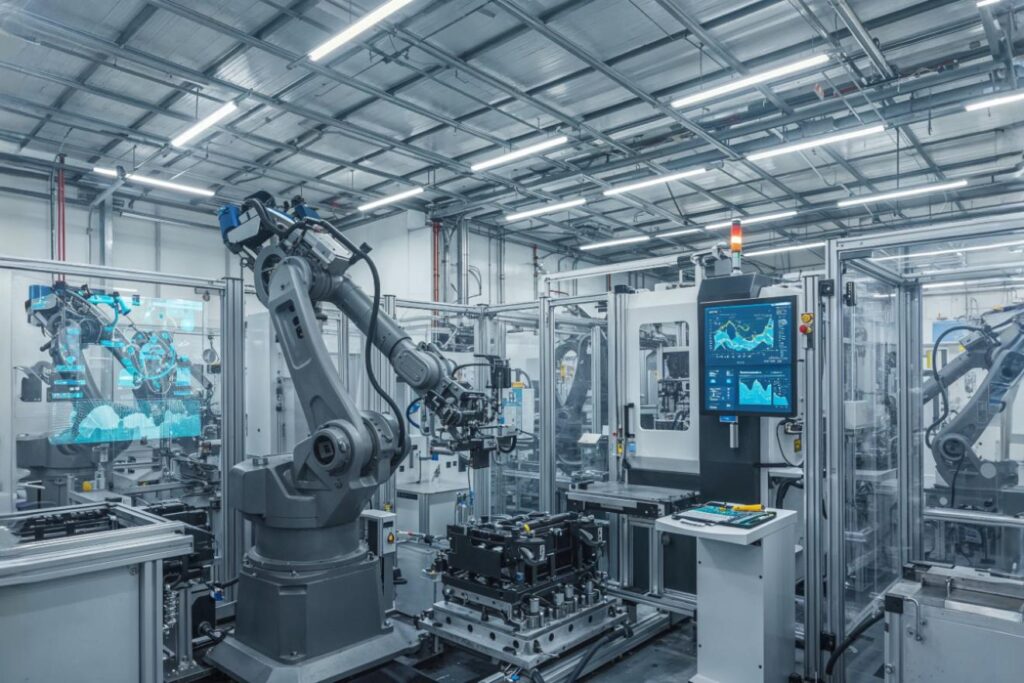
The rise of CNC machining in Vietnam is only just beginning. In the next decade, several trends will accelerate its growth:
- Automation & Industry 4.0: Expect more robotics, automated tool changers, and smart manufacturing systems.
- Advanced materials: As capabilities improve, Vietnamese shops will increasingly machine high-performance alloys like titanium, Inconel, and specialty steels.
- Specialized industries: Growth in aerospace, medical devices, and renewable energy will drive demand for even higher precision and tighter quality controls.
- Localized supply chains: More domestic suppliers for raw materials, tooling, and coatings will reduce reliance on imports and shorten lead times.
Conclusion
CNC precision machining is no longer the domain of a few established nations. Vietnam has proven that it can deliver world-class quality, cutting-edge technology, and competitive pricing, all while offering the supply chain resilience and agility modern manufacturers demand.
Navigating a new manufacturing region can feel daunting. At Align MFG, we connect companies with reliable CNC machining partners in Vietnam and across Asia. From prototype to production, we manage quality, communication, and logistics every step of the way.
Forged vs Cast: What’s the Real Difference in Strength and Cost?
Forging and casting are two foundational metal manufacturing processes that produce the majority of structural components used in automotive, aerospace, energy, and medical devices. In simple terms, forging reshapes solid metal by compressive force to align and refine its grain structure, while casting pours molten metal into a mold to form complex shapes. A growing body of studies and industry data shows forged parts often exhibit higher tensile, yield, and fatigue strength (for example, +26% tensile and +37% fatigue in representative comparisons), whereas castings excel in geometric complexity and low-to-medium volume economics.
In this article, you’ll get: clear definitions, quantified comparisons of mechanical properties, cost-per-unit models across volumes, quality and inspection considerations, application-specific guidance, decision matrices, and a balanced look at trade-offs, sustainability, and future trends.
Summary
- Strength: Forgings generally outperform castings in tensile, yield, impact, and fatigue strength due to refined and aligned grain flow and reduced internal defects.
- Cost: Castings typically have lower upfront tooling costs and are often more economical at low volumes and for complex geometries; forgings become cost-effective as volumes and strength requirements rise.
- Quality: Casting risks include porosity, inclusions, hot tears, and cold shuts; forging risks include laps/folds if poorly controlled. Proper heat treatment and inspection can elevate both.
- Applications: Choose forging for high-load, fatigue-critical, safety-critical parts (e.g., crankshafts, landing gear); choose casting for intricate housings, engine blocks, and components with internal passages.
- Rule of thumb: If strength/fatigue is mission-critical and volume is medium-high, lean forging. If complexity is high and volume is low-medium, lean casting.
What Do “Forged” and “Cast” Mean? Definitions and Core Mechanics
Forging plastically deforms hot, warm, or cold solid metal with compressive forces (presses, hammers) so grains flow along the part geometry, which enhances mechanical properties and reliability. Casting melts the alloy and pours it into a mold where it solidifies, enabling near-net shapes and complex internal features with fewer secondary operations.
Forging 101: Hot, Warm, and Cold Forging
- Hot forging works above the recrystallization temperature (for steel typically 900–1250°C or 1650–2280°F), enabling significant deformation, refined grains, and good ductility.
- Warm forging occurs in the 600–900°C (1110–1650°F) range for steel, balancing formability with dimensional control.
- Cold forging near room temperature offers superior surface finish and dimensional accuracy with work hardening; it suits smaller parts and ductile alloys.
Typical forging outcomes: aligned grain flow, reduced porosity, and high material utilization (often 85–95% for closed-die parts after trim).
Casting 101: Sand, Investment, Die, and Permanent Mold
- Sand casting: flexible, low tooling cost, broad alloy range; rougher surface and wider tolerances.
- Investment casting: wax patterns with ceramic shells; excellent detail and tighter tolerances; higher per-part cost than sand.
- Die casting: high-pressure injected molten metal (commonly aluminum, zinc, magnesium); excellent precision and surface finish at high volumes; expensive dies.
- Permanent mold casting: reusable metal molds; better surface finish than sand; good for moderate volumes.
Casting advantages include near-net shape potential, internal passages/cores, and agility in complex geometries that would be difficult to forge.
Strength Performance Frame: Quantified Property Comparisons
Forged parts generally deliver higher tensile, yield, impact, and fatigue performance than cast counterparts because forging consolidates and aligns grains, closes voids, and minimizes defect size and frequency.
Tensile and Yield Strength Comparisons
- Representative comparisons report forged parts exhibiting approximately 26% higher tensile strength and higher yield strength (e.g., 400 MPa vs 300 MPa in like-for-like alloy/process conditions) compared with cast parts of similar chemistry and heat treatment.
- Standards for testing: ASTM E8/ISO 6892 for tensile testing; ASTM A370 for steel mechanical testing protocols.
Fatigue Strength and Life
- Fatigue is highly sensitive to defects. Studies comparing forged versus cast crankshafts and similar components report about 37% higher fatigue strength for forgings and in some cases up to 50% longer fatigue life, given equivalent surface finish and heat treatment.
- Standards for testing: ASTM E466 for axial fatigue tests; surface condition per ASTM E739 methodologies for S-N curve analysis.
- Why it matters: Even small pores or inclusions act as crack initiation sites. The refined, aligned microstructure of forgings increases resistance to crack initiation and growth.
Impact Toughness and Ductility
- Forgings typically achieve higher Charpy impact values at room and sub-zero temperatures, a key reason they’re favored for safety-critical aerospace and energy parts.
- Ductility-hardness balance: With appropriate heat treatment (e.g., quench-and-temper for steels; solution and aging for Al/Ti), forgings can achieve a better strength-ductility compromise.
Defects and Reliability
- Common casting defects: gas/shrinkage porosity, inclusions, cold shuts, hot tears, misruns. These reduce fatigue resistance and sometimes leak tightness.
- Common forging defects: laps, folds, underfills, and flow-line interruptions due to die design or insufficient deformation; typically detectable and mitigated with process control.
- Inspection standards: Magnetic particle (ASTM E1444) and penetrant testing (ASTM E1417) for surface cracks; radiography (ASTM E446/E186/E280, E155 for aluminum) and ultrasonics (ASTM A609 for castings; ASTM E2375/E114 for wrought) for internal discontinuities.
Materials Lens: Steel, Aluminum, Titanium, Specialty Alloys
- Steel: Forged 1045/4140 show higher yield and fatigue strength versus comparable cast steel grades after similar heat treatment. Ductile iron casting can be competitive in certain stiffness/weight targets but generally trails forgings in fatigue-critical uses.
- Aluminum: Die cast Al offers excellent net-shape and surface finish but may contain microporosity; forged 6xxx/7xxx aluminum often outperforms in fatigue and impact loads.
- Titanium: Forged Ti-6Al-4V is standard for aerospace structural parts; cast Ti is used in some medical and aero components but typically with stricter inspection due to defect sensitivity.
- Specialty alloys (Ni, Co): Casting is common for intricate turbine components (with rigorous controls); forging is preferred for disks, rings, and shafts requiring high integrity.
Table 1. Representative mechanical property comparison (illustrative, actual values depend on alloy, geometry, and heat treatment; test methods: ASTM E8/E466/A370)
| Property (room temp) | Forged medium-alloy steel | Cast steel (comparable chemistry) | Forged aluminum (6xxx/7xxx) | Die cast aluminum (Al-Si) |
| Tensile strength | +20–30% vs cast (e.g., 800–950 MPa) | Baseline (e.g., 620–750 MPa) | 350–550 MPa | 240–320 MPa |
| Yield strength | Often 400–700 MPa | Often 300–500 MPa | 250–480 MPa | 160–260 MPa |
| High-cycle fatigue (10^7) | +30–40% vs cast | Lower due to porosity | 120–220 MPa | 70–140 MPa |
| Impact toughness (Charpy) | Higher, better at low T | Lower on average | Moderate-high | Lower on average |
Cost Economics Frame: Tooling, Unit Cost, and Volume Breakpoints
Casting typically wins on low upfront cost and design freedom at low volumes, while forging becomes cost-effective as volumes grow and strength-critical performance is required.
Cost Model Components
Unit cost ≈ (Tooling cost / Volume) + Material + Processing (forge/ pour + heat treat) + Machining + Quality/Inspection + Scrap/Rework.
- Material utilization: Forging often achieves 85–95% utilization (after flash trim) with well-designed preforms; casting utilization varies by process—die casting can be very efficient, sand casting may require more machining stock.
- Machining: Near-net castings may reduce machining for complex shapes; however, porosity can drive rework. Forgings may need machining stock but benefit from predictable, sound material.
Tooling and Setup Costs (typical ranges; vary widely by size/complexity)
- Closed-die forging: moderate-to-high tooling investment; robust dies; lead time weeks.
- Sand casting: low pattern cost; fastest to iterate.
- Investment casting: moderate tooling; ceramic shell cycles.
- Die casting: highest die cost; fast cycle times and low unit cost at scale.
Volume Scenarios and Break-Even Analysis
The figure below uses indicative values to show how the economics shift with volume. Use your own RFQ data for exact breakpoints.
Table 2. Indicative cost-per-unit vs volume (normalized cost index; lower is better)
| Process | Tooling cost (relative) | 100 units | 1,000 units | 10,000 units | Notes |
| Sand casting | Low | 1.00 | 0.80 | 0.70 | Best for low volume, large parts |
| Investment casting | Medium | 1.30 | 0.85 | 0.75 | Tighter tolerances, complex shapes |
| Closed-die forging | Medium-high | 1.50 | 0.90 | 0.65 | Strong lifecycle economics |
| Die casting (Al/Zn) | High | 2.00 | 1.00 | 0.50 | Requires high volumes to amortize dies |
Machining, Tolerances, and Surface Finish
- Forgings: good dimensional stability post-heat treat; machining stock required at bosses/parting lines; near-net options reduce stock.
- Castings: investment and die castings offer tighter as-cast tolerances and smoother surfaces; sand castings require more machining.
Table 3. Typical tolerances and surface finishes (guideline values; consult supplier capability)
| Process | Linear tolerance | Surface finish (Ra) |
| Sand casting | ±0.8–3.0 mm (±0.03–0.12 in) | 6.3–25 μm (250–1000 μin) |
| Investment casting | ±0.1–0.5 mm (±0.004–0.020 in) | 1.6–3.2 μm (63–125 μin) |
| Die casting (Al/Zn) | ±0.05–0.25 mm (±0.002–0.010 in) | 0.8–1.6 μm (32–63 μin) |
| Closed-die forging | ±0.5–1.5 mm (±0.020–0.060 in) typical pre-machine | 3.2–6.3 μm (125–250 μin) |
Scrap, Rework, and Inspection Costs
- Casting scrap stems from porosity, misruns, and inclusions; rigorous gating, degassing, and process control reduce this but add cost.
- Forging scrap often relates to laps/underfill; improved die design and preform control minimize it.
- Quality assurance (NDT, destructive testing) is a non-trivial cost driver for safety-critical parts in both processes.
Quality Assurance Frame: Standards, Specs, and Inspection
Meeting specified properties and defect thresholds requires process control, heat treatment discipline, and appropriate inspection plans matched to risk.
Material and Process Standards
- Forgings: ASTM A668/A788 (steel forgings), AMS specs for aerospace forgings.
- Castings: ASTM A27/A216 (carbon/low-alloy steel castings), ASTM A356 (aluminum castings), ASTM A536 (ductile iron), and AMS/ISO equivalents.
- Supplier process standards: ISO 9001; IATF 16949 for automotive; AS9100 for aerospace.
Heat Treatment and Grain Control
- Steel: normalize, quench-and-temper to balance strength and toughness; forging can leverage controlled deformation + heat to refine grains.
- Aluminum: solution treat + age (T6/T7) to reach peak strength and fatigue resistance.
- Titanium: solution treat + age; beta anneals for certain applications.
NDT Plans by Risk Class
- Surface: PT (ASTM E1417) for non-ferrous; MT (ASTM E1444) for ferromagnetic steels.
- Internal: RT (ASTM E446/E186/E280; E155 for aluminum) to characterize porosity/shrinkage; UT (ASTM A609 for castings, ASTM E2375/E114 for wrought).
- Dimensional: CMM inspection; CT scanning increasingly used for complex castings with internal passages.
Application Suitability Frame: Which Process Fits Which Part?
Direct answer: Across heavy industries, choose forging for components that see high cyclic loads, shock, or pressure containment where defect tolerance is low; choose casting for complex shapes, internal flow paths, or large one‑piece structures where geometry and cost efficiency dominate.
Oil & Gas
Forged (strength/pressure-critical):
- Wellhead and Christmas tree components: flanges, hubs, adapters, clamps, hangers (API 6A classes) for pressure integrity and toughness.
- Drilling components: drill collars, subs, kellys, rotary/drive shafts, tool joints—high torsion and bending fatigue.
- Production hardware: BOP rams/bonnets, choke/kill line fittings, high-pressure unions—fracture toughness and reliability in sour service (NACE MR0175/ISO 15156).
- Materials: 4130/4140/4340 low-alloy steels, 410/13Cr stainless, duplex/super duplex, Ni-based alloys—often forged then Q&T or solution aged.
Cast (complex geometry/flow management):
- Valve and pump bodies, manifolds, separators, compressor casings—internal passages and boss features benefit from casting.
- Large, integrated housings where weight is secondary to complexity and cost.
- Notes: Use high-integrity steel/CRAs with rigorous NDT; HIP and CT scanning mitigate porosity for pressure-rated castings.
Railway
Forged (fatigue/impact-critical):
- Axles (AAR/EN), wheel centers/rings, crankshafts—rotating parts with high bending fatigue and impact demands.
- Coupler draw hooks, yokes (in some designs), brake rigging links, suspension and traction rods—shock loads and low-temperature toughness.
- Bogie pins, draft gear elements requiring high toughness.
Cast (large structural/complex shapes):
- Freight truck (bogie) side frames and bolsters—large, complex steel castings proven in service.
- Coupler bodies and knuckles (commonly cast steel) with robust heat treatment and inspection.
- Housings and brake caliper bodies where geometry and manufacturability favor casting.
Construction
Forged (high shock/wear/load-path parts):
- Crane hooks, shackles, lifting eyes, swivels—impact-critical hardware with strict defect tolerance.
- Track links/shoes, bucket linkage pins and bushings, hydraulic cylinder rods/ends—abrasion and cyclic loads.
- Cutting edges, ripper shanks, and high-strength connectors—grain flow along load paths improves durability.
Cast (near-net, complex, wear-shaped parts):
- Ground-engaging tool teeth/adapters, complex wear parts—optimized geometries and alloys (e.g., high-Mn, low-alloy cast steels).
- Gearbox housings, pump/valve bodies, engine blocks/heads on machinery—internal passages and mounting features.
- Counterweights and large bases where size and cost dominate over fatigue.
Truck & Trailer
Forged (steering/suspension/towing critical):
- Steering knuckles, control arms, tie-rod ends, pitman/idler arms—fatigue and impact performance.
- Kingpins, fifth‑wheel pins, tow hooks/eyes, drawbar eyes, hitch components—shear and shock loading.
- Axle spindles, spring seats, U‑bolt plates where concentrated stresses occur.
- Wheels: forged aluminum wheels favored for high strength-to-weight and fatigue life.
Cast (housings/rotating mass with complex geometry):
- Differential and axle housings, brake calipers, brake drums (cast iron), some wheel hubs—shape complexity and damping benefits.
- Engine/transmission cases and mounts—integrated features and passageways.
- Notes: For weight-sensitive builds, compare forged vs cast hubs/wheels; consider lifecycle fatigue and corrosion.
Industrial (General Machinery, Power Transmission, Material Handling)
Forged (shafts/rotors/load-bearing cores):
- Drive shafts, gear blanks, crank and eccentric shafts, rolls, press rams—core integrity under torsion/bending.
- Lifting hooks, clevises, eyebolts, rigging hardware—safety-critical with high impact demands.
- High-pressure fittings, unions, flanges—sound material for sealing and fatigue.
Cast (housings/impellers/complex internals):
- Pump and compressor casings, impellers, volutes—flow-optimized internal passages.
- Large machine bases, frames, gearboxes—vibration damping and integrated features.
- Fans, blower housings, and complex covers—cost-effective near-net shapes.
- Notes: For rotating cast components (impellers/fans), specify NDT and balance requirements; HIP or upgraded processes improve fatigue resistance.
Decision cues across these sectors
- Choose forging when: cyclic or impact loads are high; pressure containment and leak-tightness are critical; certification requires high toughness/reliability; failure consequences are severe.
- Choose casting when: internal channels or complex shapes are essential; part size or integration favors one-piece construction; volumes are low-to-medium with tight cost targets; damping or thermal mass is beneficial.
- Hybrid strategies: cast the complex body and forge the highly stressed interfaces (e.g., forged hubs/shafts mated to cast housings), or use HIP and CT for critical castings to approach forging-like reliability.
Micro-Context: Trade-Offs, Risks, and Counterpoints
When Casting Beats Forging
- Low volume where tooling amortization dominates.
- Complex internal features (coolant/oil passages) that would be expensive to machine from forgings.
- Tight as-cast tolerances and smooth surfaces via investment or die casting reduce machining.
When Forging Beats Casting
- High mechanical integrity and fatigue life are essential (e.g., rotating shafts, suspension).
- Severe service environments (impact, low temperature) where higher toughness is mandatory.
- Certification pathways that favor wrought/forged microstructures and allow smaller inspection burdens for the same reliability target.
Common Misconceptions (quick answers)
- “Casting is always cheaper.”
Not at high volumes or when high scrap/rework erases savings; die cost for forging can amortize quickly at scale.
- “Forging can’t make complex shapes.”
Near-net forging, multi-impression die sets, and finish machining can achieve substantial complexity; still, intricate internal cavities favor casting.
- “All castings are porous.”
High-quality foundries control gas/shrinkage; rigorous NDT and process control can deliver low-porosity castings suitable for demanding uses.
FAQs
Is a forged part always stronger than a cast part?
Generally yes for like alloys and heat treatments, especially in fatigue and impact performance, because forging minimizes defects and aligns grains. But high-integrity castings can meet many strength targets with proper design and inspection.
At what volume does forging become cheaper than casting?
It depends on tooling cost, complexity, and machining. As a rule of thumb, closed-die forging becomes competitive in the low thousands of units, while die casting requires higher volumes (often 10,000+ units) to amortize expensive dies.
Can heat-treated cast parts match forged strength?
Heat treatment improves both, but castings’ defect sensitivity typically limits fatigue performance relative to wrought/forged material.
What about tolerances and surface finish?
Investment and die casting deliver tighter as-cast tolerances and smoother surfaces; forgings often require more finish machining but yield stable, sound stock.
How do inspection needs differ?
Castings often require more intensive radiography/UT to mitigate porosity risks. Forgings focus on surface and internal integrity via MT/PT and UT; plan inspection to match risk and certification.
Conclusion: Strength vs Cost
The real difference in strength and cost comes down to microstructure and manufacturing economics. Forgings typically deliver superior mechanical performance—often around 26% higher tensile and 37% higher fatigue strength in representative comparisons—because grains are refined and aligned and internal defects are minimized. Castings shine in complexity and lower upfront cost, often winning at low volumes and for intricate geometries or internal passages. Your best choice depends on property criticality, geometry, volume, and certification requirements.
Tempering Steel: Definition, Process, Temperatures, Microstructure, Types
Tempering steel is the controlled reheating of quenched steel to a temperature below the lower critical point, typically between 150 to 700 °C, followed by a soak and a controlled cool. The goal is simple yet profound. reduce brittleness, relieve internal stresses, and tune the balance between hardness and toughness so the steel can perform reliably in service.
From the straw and blue tempering colors used by ancient swordsmiths to the multi zone vacuum and atmosphere furnaces used in industry today, the principle has remained the same. take an overly hard and brittle microstructure and make it durable. At Align MFG, we apply these same fundamentals across our manufacturing hubs in Thailand, Vietnam, and India, using modern process control to deliver consistent performance in industrial parts.
In this first half of the article, you will learn what tempering is, why manufacturers rely on it, how the process works step by step, what happens to the steel microstructure, the major types of tempering with their best use cases, and how temperature relates to properties. The second half will cover applications by industry, advantages and limitations, comparisons to other heat treatments, quality control, troubleshooting, safety, and future trends.
What Is Tempering Steel
Tempering is a heat treatment performed after quenching that reheats steel to a temperature below the austenite formation threshold in order to reduce brittleness, stabilize the microstructure, and achieve a targeted balance of hardness and toughness. The process is essential because as quenched martensitic steel is hard but prone to cracking under impact or cyclic loads. Tempering moderates that brittleness without discarding the beneficial hardness entirely.
Historically, craft workers used tempering colors on polished steel surfaces to estimate temperature. straw at about 200 °C, brown near 240 to 260 °C, purple near 280 to 300 °C, and blue near 300 to 320 °C. Modern manufacturing uses thermocouples, programmed recipes, and controlled atmospheres, but the principle of precise temperature control remains the foundation.
Why Temper Steel in Manufacturing
Tempering provides a set of practical, high value benefits that align with real world performance needs.
- It increases toughness and ductility so parts can absorb energy without catastrophic fracture.
- It relieves internal stresses from quenching, which reduces the risk of cracking and distortion.
- It stabilizes dimensions, which improves fit and tolerance control during finishing and assembly.
- It tunes hardness and wear resistance to the working conditions of the part.
- In certain alloy systems, it enables secondary hardening for improved hot strength and wear resistance at higher temper temperatures.
Without tempering, quenched steels remain vulnerable to impact failure, quench cracking, and premature fatigue. With tempering, the result is a more forgiving and predictable material that can endure service loads with confidence.
A helpful analogy is to think of quenching as an intense workout that leaves the material tense and strained. Tempering is the active recovery session that relaxes the microstructure and brings performance into an optimal range.
How Tempering Works. Heating, Dwelling, Cooling
Tempering follows a three stage sequence that can be summarized as Heating followed by Dwelling followed by Cooling. Each stage is controlled to achieve specific metallurgical outcomes.
Step 1. Heating
- Target range. 150 to 700 °C depending on steel grade, carbon content, alloying elements, and property targets.
- Selection logic. Lower temperatures favor retention of higher hardness but limited toughness increase. Higher temperatures increase toughness and ductility at the expense of hardness.
- Timing. For most steels, tempering should occur soon after quenching to reduce the risk of delayed cracking.
- Rate control. Heat rates are managed to avoid steep thermal gradients. Larger or more complex parts often use staged preheats to ensure even temperature rise.
- Atmosphere. To minimize scale and decarburization, parts are tempered in vacuum, inert gas, or controlled atmospheres. Choice depends on material, surface finish requirements, and furnace capability.
Step 2. Dwelling
- Purpose. The soak allows carbon to diffuse, carbides to precipitate, and residual stresses to relax. This is where most of the property tuning occurs.
- Typical soak time. A common starting rule is about one hour per inch of section thickness, adjusted to alloy and specification. Thin sections or highly conductive parts may require shorter times.
- Uniformity. Proper racking and spacing promote uniform temperature and reduce shadowing or cold spots inside the furnace.
Step 3. Cooling
- Method. Most tempering cycles end with air cooling to ambient temperature.
- Special cases. Certain alloy steels are susceptible to temper embrittlement if held or cooled slowly through specific temperature bands. In such cases, faster cooling from the tempering temperature can be beneficial.
- Surface control. Atmosphere management continues to matter during cool down. In many operations, parts remain under protective gas during the initial cool to minimize oxidation.
Microstructural Changes During Tempering
Tempering transforms an unstable, stressed microstructure into a stable and tougher one through diffusion driven processes. The main actors are martensite, retained austenite, ferrite, and carbides.
Martensite Decomposition and Carbon Diffusion
Quenching creates a supersaturated martensite with a distorted lattice and very high dislocation density. During tempering, carbon atoms diffuse and reduce lattice distortion, which lowers internal stress and brittleness. At low tempering temperatures, very fine transition carbides precipitate within the martensite. As temperature rises, these transition carbides evolve and coarsen, and the microstructure gradually approaches tempered martensite, which is ferritic matrix containing uniformly distributed carbides.
Retained Austenite Transformation
Some quench conditions and alloy chemistries leave a fraction of austenite untransformed at room temperature. Tempering destabilizes retained austenite, which can transform during the cycle or in a subsequent temper. In tool steels and high alloy grades, a double temper is often used to transform retained austenite more completely and then refine the resultant structure. In critical applications, a cryogenic step before tempering can reduce retained austenite content further.
Precipitation and Secondary Hardening
Alloyed steels that contain elements like chromium, molybdenum, vanadium, and tungsten can show secondary hardening when tempered at higher temperatures. In this regime, very fine alloy carbides precipitate, which can raise hardness after an initial drop. This is advantageous for hot work and high speed tool steels where wear resistance and hot strength are needed at elevated service temperatures.
Relating these transformations to core materials science, the iron carbon phase diagram defines the austenite stability boundaries, while time temperature transformation and continuous cooling transformation curves help predict what happens during quench and temper cycles. In practice, tempering is about guiding diffusion and precipitation to a target end state.
Types of Tempering and When to Use Each
Tempering strategies vary by temperature, number of cycles, and method of heat input. Selection depends on alloy, section size, part geometry, and the required property profile.
Low Temperature Tempering. 150 to 250 °C
- Purpose. Stress relief and modest toughness increase while retaining high hardness.
- Typical uses. Cutting tools, bearings, gauge blocks, and parts that need maximum wear resistance with limited impact loading.
- Outcomes. Internal stress reduction, slight decrease in hardness, and controlled microstructural stabilization.
Medium Temperature Tempering. 300 to 450 °C
- Purpose. Balanced hardness and toughness for parts that see both wear and dynamic loading.
- Typical uses. Springs, wear plates, gears that need a compromise between surface durability and core toughness.
- Outcomes. More significant toughness improvement with a moderate drop in hardness relative to low temperature tempering.
High Temperature Tempering. 450 to 700 °C
- Purpose. Maximum toughness and ductility with substantial stress relief and dimensional stability.
- Typical uses. Structural components, heavy duty shafts, automotive and industrial machinery parts where impact and fatigue resistance dominate.
- Outcomes. Lower hardness, high toughness, stable dimensions, and improved machinability when post temper finishing is required.
Double Tempering
- Purpose. Reduce retained austenite content, homogenize carbide distribution, and stabilize the microstructure for demanding service.
- Typical uses. Cold work and hot work tool steels such as D2 and H13, and high strength alloy steels for aerospace grade parts.
- Outcomes. Improved dimensional stability, more consistent hardness through section, better fatigue performance.
Precipitation Tempering and Secondary Hardening
- Purpose. Exploit alloy carbide precipitation to regain hardness at higher temper temperatures.
- Typical uses. High speed steels and Cr Mo V tool steels that must retain wear resistance at elevated temperatures.
- Outcomes. A hardness valley followed by a hardness rise at higher temper ranges, along with improved hot strength.
Subcritical Tempering versus Intercritical Treatments
- Conventional tempering is subcritical, meaning always below the Ac1 temperature so that no austenite forms. This is the standard approach for quench and temper processes.
- Intercritical treatments are specialized cycles that briefly enter the austenite formation range for certain alloy designs. These are not typical for standard tempering and should be used only with a validated metallurgical rationale.
Induction Tempering and Flash Tempering
- Induction tempering uses localized heating for rapid and targeted tempering of selective areas such as gear teeth or welded regions. The short cycle time and precision of heat placement can minimize distortion and increase throughput.
- Flash tempering is an ultra rapid temper used primarily on very thin sections or surface hardened cases. It relies on brief exposure to the target temperature with immediate cool down.
Temperature and Property Relationships
Tempering temperature is the most powerful lever for tuning hardness, toughness, ductility, and wear resistance. As a general rule, higher tempering temperatures give more toughness and ductility with lower hardness, while lower tempering temperatures preserve hardness at the cost of brittleness. Some alloy systems show secondary hardening at higher temperatures due to fine alloy carbide precipitation.
Tempering Colors as Practical Guides
Although not a replacement for thermocouples and calibrated control, tempering colors on a polished surface provide a quick visual cue in workshop settings.
- Pale straw. about 200 °C
- Dark straw to brown. about 230 to 260 °C
- Purple. about 280 to 300 °C
- Blue. about 300 to 320 °C
- Gray. above about 330 °C
These colors depend on surface condition, atmosphere, and lighting. They are best considered supplemental indicators rather than primary controls.
Representative Property Trends by Tempering Range
The following tables summarize typical relationships between tempering temperature and mechanical outcomes. Values are representative and depend on chemistry, prior austenitization, quench severity, section size, and temper time.
Table 1. Tempering temperature and typical outcomes for common steels
| Steel grade | Tempering temperature °C | Typical hardness HRC | Toughness trend | Wear resistance | Notes |
| 1045 medium carbon | 200 to 250 | 50 to 55 | Slight increase | High | Stress relief and minor softening |
| 1045 medium carbon | 400 to 500 | 35 to 45 | Significant increase | Moderate | Balanced properties for shafts and pins |
| 1045 medium carbon | 600 to 650 | 20 to 30 | High | Low | Maximum ductility and machinability |
| Steel grade | Tempering temperature °C | Typical hardness HRC | Toughness trend | Wear resistance | Notes |
| 4140 alloy | 200 to 250 | 52 to 58 | Moderate increase | High | Useful for wear critical parts with limited impact |
| 4140 alloy | 400 to 500 | 38 to 48 | Large increase | Moderate | Common range for gears and shafts |
| 4140 alloy | 550 to 650 | 28 to 35 | High | Lower | Suitable for structural duties with impact loads |
| Steel grade | Tempering temperature °C | Typical hardness HRC | Toughness trend | Wear resistance | Notes |
| D2 tool steel | 150 to 250 | 58 to 62 | Small increase | Very high | First temper in double temper practice |
| D2 tool steel | 450 to 550 | 56 to 60 | Moderate | Very high | Secondary hardening region for wear tools |
| D2 tool steel | 575 to 600 | 54 to 57 | Moderate to high | High | Often used for dies needing toughness and wear |
| Steel grade | Tempering temperature °C | Typical hardness HRC | Toughness trend | Wear resistance | Notes |
| H13 hot work | 500 to 600 | 46 to 52 | Moderate to high | High at temperature | Typical double temper range |
| H13 hot work | 600 to 650 | 44 to 48 | High | Moderate | Improves thermal fatigue resistance |
| H13 hot work | 650 to 700 | 40 to 44 | High | Moderate to low | Maximizes toughness and stability |
| Steel grade | Tempering temperature °C | Typical hardness HRC | Toughness trend | Wear resistance | Notes |
| M2 high speed | 200 to 300 | 63 to 66 | Small | Very high | Retains high hardness at low temper |
| M2 high speed | 500 to 560 | 60 to 64 | Moderate | Very high | Secondary hardening plateau |
| M2 high speed | 560 to 600 | 58 to 62 | Moderate | High | Used for hot strength and wear at temperature |
Key patterns to note
- Medium carbon steels such as 1045 show a steady hardness decrease with increasing temper temperature and a consistent rise in toughness.
- Alloy steels such as 4140 offer broad temper windows that can be tuned for balanced properties. This is why they are common in shafts, gears, and fasteners.
- Cold work tool steels such as D2 show strong wear resistance across a wide temper range, with a beneficial secondary hardening response in the higher temper region.
- Hot work and high speed steels such as H13 and M2 leverage secondary hardening to sustain hardness at elevated operating temperatures.
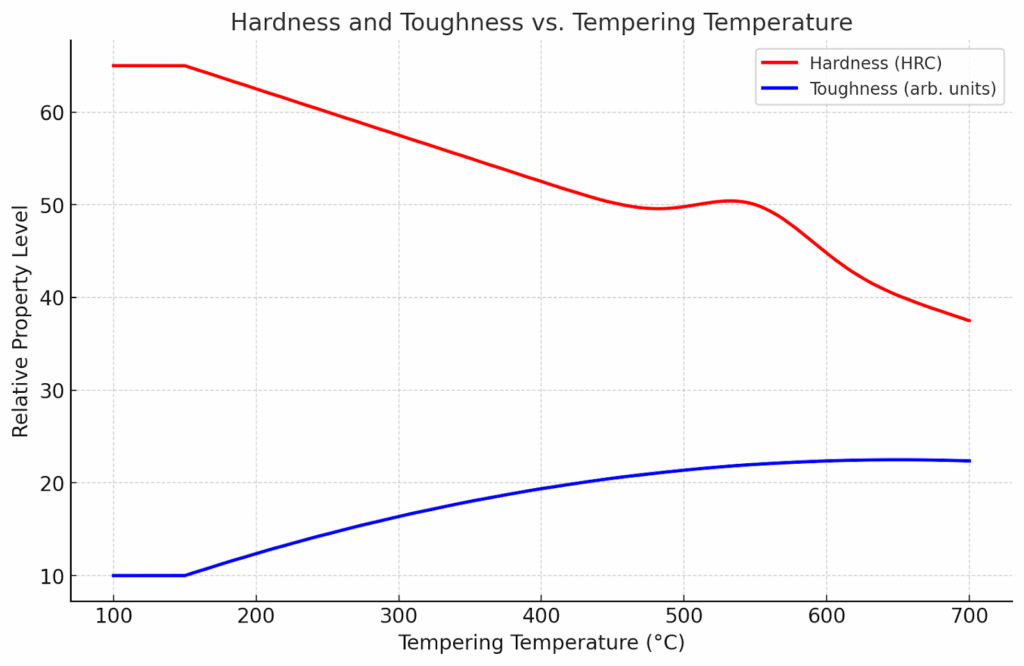
Practical Guidance for Selecting Tempering Temperatures
- Start with the alloy data sheet and recommended temper ranges for the intended application. Target the lowest temperature that meets toughness and stability requirements if wear resistance is critical. Choose higher temper temperatures if impact and fatigue performance dominate.
- Consider double temper cycles for tool steels and high hardenability alloys. The first temper reduces brittleness and transforms some retained austenite. The second temper homogenizes the microstructure and stabilizes properties.
- Avoid dwelling in temperature ranges known to produce temper embrittlement for susceptible steels. If the application or alloy is at risk, plan for faster cooling from the temper.
- Use witness samples and hardness checks to verify time and temperature choices before full scale production. Document the relationship between hardness and temper temperature for your specific material lot and section size.
Industrial Applications and Case Examples
Tempering tailors steel to the in service loads and environments of five core sectors we support at Align MFG. Oil and Gas, Railway, Construction, Truck and Trailer, and Industrial equipment. By selecting the right tempering window and cycle, we trade just enough hardness for toughness, dimensional stability, and fatigue strength to match each component’s duty.
Oil and Gas
These components see high loads, pressure cycling, abrasion, and sometimes corrosive media. Tempering choices prioritize strength with high impact toughness and tight hardness control across sections.
- Downhole tools such as drill collars, jars, and subs
Typical approach. quench and temper 4140, 4145H, or 4330V mod at 500 to 650 °C to achieve high toughness with controlled hardness through section
- Wellhead bodies, flanges, and valve internals
Typical approach. quench and temper 8630M or 4130 at 500 to 650 °C for fracture resistance. For martensitic stainless such as 410 or 420, temper at 200 to 350 °C to balance hardness and corrosion performance
- Pressure control connectors and adapters
Typical approach. high toughness temper on 8630M at 550 to 650 °C to mitigate crack initiation at stress concentrations
Railway
Railway hardware demands long life under bending and impact with strict dimensional control. The temper strategy aims at high fatigue strength and impact toughness.
- Axles and large shafts
Typical approach. quench and temper 42CrMo4 or 4140 at 500 to 650 °C for a tough core with good surface durability
- Couplers, yokes, and draft gear components
Typical approach. quench and temper 8630 or 4330 at 450 to 600 °C for strength with reliable notch toughness
- Bogie links, brake levers, and brackets
Typical approach. quench and temper medium carbon steels such as 1045 to 1050 at 400 to 550 °C to balance wear and impact resistance
Construction
Equipment faces abrasive wear, shock loading, and outdoor exposure. Tempering balances wear resistance with the toughness needed to avoid brittle failures in the field.
- Ground engaging tools such as bucket teeth and cutting edges
Typical approach. quench and temper boron alloy steels such as 10B38 or 15B30 at 200 to 450 °C depending on the hardness target and wear requirement
- Hydraulic cylinder rods and pins
Typical approach. quench and temper 1045 or 4140 at 400 to 600 °C for stable dimensions, good toughness, and machinability after temper
- High strength anchor rods and heavy fasteners
Typical approach. quench and temper 4140 at 450 to 600 °C to meet strength class while preserving ductility for installation
Truck and Trailer
Components need endurance under vibration, road shock, and varying loads. Tempering targets fatigue strength and reliable toughness.
- Axles, spindles, and hubs
Typical approach. quench and temper 4140 or 4340 at 500 to 650 °C for high toughness and dimensional stability
- Leaf springs and suspension links
Typical approach. quench and temper 5160 or Si Cr spring steels at 350 to 500 °C to achieve high yield strength with endurance under cyclic loading
- Kingpins, drawbar eyes, and fifth wheel plates
Typical approach. quench and temper 4140 at 450 to 600 °C for impact resistance and wear durability
- Wheel studs and U bolts
Typical approach. case harden medium carbon boron steels such as 10B21, then temper subcritically at 200 to 300 °C to stabilize the case and relieve stresses
Industrial
This covers general machinery, power transmission, and plant equipment with many balance of property requirements. Tempering is the lever that tunes hardness, wear, and fatigue.
- Gears, pinions, and shafts
Typical approach. quench and temper 4140 or 4340 at 400 to 550 °C for a balanced hardness with strong tooth root toughness
- Sprockets, couplings, and drive pins
Typical approach. quench and temper 1045 or 4140 at 400 to 550 °C to blend wear resistance with toughness
- Grade 8 type fasteners and studs
Typical approach. case harden medium carbon boron steels, then temper at 200 to 350 °C for controlled case hardness and a tough core
- Press tooling and holders
Typical approach. double temper D2 or H13 at 500 to 650 °C to stabilize the microstructure and improve resistance to wear or thermal fatigue
| Industry | Component | Typical steel | Tempering range °C | Primary property goals |
| Oil and Gas | Drill collar and jar body | 4140, 4145H, 4330V mod | 500 to 650 | High impact toughness and stable hardness through section |
| Oil and Gas | Wellhead or valve body | 8630M or 4130 | 500 to 650 | Fracture resistance and dimensional stability |
| Oil and Gas | Valve trim and seats | 410 or 420 martensitic stainless | 200 to 350 | Edge retention with balanced toughness and corrosion performance |
| Railway | Axle | 42CrMo4 or 4140 | 500 to 650 | Fatigue strength and impact toughness |
| Railway | Coupler and yoke | 8630 or 4330 | 450 to 600 | High strength with reliable notch toughness |
| Railway | Bogie link and brake lever | 1045 to 1050 | 400 to 550 | Balanced wear resistance and impact performance |
| Construction | Bucket tooth and cutting edge | 10B38 or 15B30 | 200 to 450 | Surface hardness for abrasion with adequate toughness |
| Construction | Hydraulic rod and pin | 1045 or 4140 | 400 to 600 | Dimensional stability and core toughness |
| Construction | Anchor rod and heavy fastener | 4140 | 450 to 600 | Strength class with ductility for installation |
| Truck and Trailer | Axle and hub | 4140 or 4340 | 500 to 650 | Fatigue life and impact resistance |
| Truck and Trailer | Leaf spring | 5160 or Si Cr spring steel | 350 to 500 | High yield strength and endurance under cyclic load |
| Truck and Trailer | Kingpin or fifth wheel plate | 4140 | 450 to 600 | Impact toughness and wear durability |
| Industrial | Gear and pinion | 4140 or 4340 | 400 to 550 | Balanced tooth hardness with root toughness |
| Industrial | Sprocket and drive pin | 1045 or 4140 | 400 to 550 | Wear resistance with robust core |
| Industrial | Tool holder and die shoe | D2 or H13 | 500 to 650 | Stable microstructure and resistance to wear or thermal fatigue |
Advantages and Limitations of Tempering
Tempering delivers safer, tougher, and more stable components, but it does introduce process considerations and constraints.
Advantages
- Major toughness increase with a controlled reduction in hardness
- Relief of residual stress and reduction in quench cracking risk
- Dimensional stability that improves fit and finish in precision assemblies
- Ability to tune properties for wear, impact, or fatigue based on temperature selection
- Secondary hardening in select alloy systems for improved hot strength and wear
Limitations and risks
- Excessive softening if temperature or time exceeds specification
- Susceptibility to temper embrittlement in certain temperature bands in alloy steels
- Oxidation and decarburization if atmosphere is not controlled
- Distortion if heating and cooling are non uniform or if prior quenching left significant stress
- Energy consumption and cycle time that must be managed in production planning
Counterpoint to the limitations
- Inadequate tempering leaves brittle structures that can fail suddenly. Excessive tempering reduces wear life. The solution is disciplined control of temperature, time, atmosphere, and load configuration.
Comparative Analysis. Tempering versus Other Heat Treatments
Tempering is distinct from other thermal cycles because it modifies a quenched martensitic structure without recreating austenite. Other treatments reset or replace the microstructure.
Tempering versus Annealing
- Annealing softens steel by allowing full recovery and recrystallization, often followed by slow cooling. It is used to maximize ductility and machinability, not to maintain high strength.
- Tempering retains a significant portion of strength and hardness while improving toughness.
Tempering versus Normalizing
- Normalizing heats steel above the austenite region and air cools to produce a fine pearlitic structure with refined grain size. It is often a conditioning step before machining or further heat treatment.
- Tempering follows quenching and targets stress relief and property tuning in martensite.
Tempering versus Austempering and Marquenching
- Austempering transforms austenite to bainite by isothermal holding. It avoids martensite and can give high toughness with uniform properties.
- Marquenching reduces thermal gradients by quenching to a temperature just above martensite finish and equalizing before final cool. It still requires tempering to reduce brittleness.
Tempering versus Induction Hardening and Case Hardening
- Induction hardening creates a hardened surface layer by rapid austenitization and quench, followed by a subcritical temper to relieve stress. The core remains tough.
- Case hardening by carburizing or carbonitriding creates a hard case with a tough core. Parts are tempered to stabilize the case and prevent brittle fracture.
Comparison of common heat treatments
| Process | Primary goal | Microstructure after process | Typical follow up |
| Tempering | Toughness and stability after quench | Tempered martensite with carbides | Often double temper for alloy steels |
| Annealing | Maximum ductility and softness | Ferrite and pearlite with coarse carbides | None or normalizing |
| Normalizing | Grain refinement and uniformity | Fine pearlite and ferrite | Machining or further heat treatment |
| Austempering | Bainitic strength and toughness | Bainite | May not need tempering |
| Marquenching | Reduce quench stresses | Martensite with lower gradients | Tempering |
| Induction hardening | Hard case with minimal distortion | Hardened surface, tough core | Subcritical temper |
| Carburizing case hardening | Hard wear resistant case | High carbon martensite in case, tough core | Tempering to stabilize the case |
Quality Control, Process Monitoring, and Compliance
Effective tempering requires tight control of temperature, time, and atmosphere with verification of resulting properties. Robust quality systems make results predictable and repeatable across lots and facilities.
Furnace control and pyrometry
- Calibrate sensors and controllers at defined intervals, and use separate load thermocouples on representative parts to verify soak temperature.
- Perform temperature uniformity surveys to ensure hot zones do not deviate beyond allowed limits across the working volume.
- Execute system accuracy tests to confirm instrument and sensor agreement.
Atmosphere and vacuum management
- Use vacuum, inert gas, or controlled atmospheres to prevent scale and decarburization.
- Monitor dew point or oxygen potential to keep surfaces clean and dimensions within tolerance.
- Select fixtures and trays that do not shed scale or contaminate the load.
Testing and verification
- Hardness testing with appropriate scales confirms the temperature selection and soak time. Microhardness can profile through section to reveal gradients.
- Mechanical testing such as tensile and impact evaluates strength and toughness when required by application.
- Metallographic evaluation confirms tempered martensite morphology and carbide distribution. When needed, retained austenite can be checked by magnetic or diffraction methods.
Data and statistical control
- Use run charts for hardness and critical dimensions to detect drift.
- Track process capability with simple measures of spread and centering.
- Maintain full traceability of heat lot, furnace cycle data, and inspections to support audits and continuous improvement.
Troubleshooting Tempering Issues
Most tempering problems can be traced to errors in temperature, time, atmosphere, or material input. Rapid diagnosis and correction prevent scrap and field failures.
Under tempering
- Symptoms. High hardness, brittle fractures, low toughness in impact tests
- Causes. Tempering temperature too low, insufficient soak time, furnace out of calibration
- Fix. Increase temperature or time within specification and verify setpoints with independent instrumentation
Over tempering
- Symptoms. Lower than expected hardness, early wear, excessive deformation under load
- Causes. Excessive temperature or soak time, especially in small sections that heat quickly
- Fix. Reduce temperature or time. If hardness loss is severe, consider re heat treat starting from austenitization
Temper embrittlement
- Symptoms. Drop in Charpy toughness, intergranular fracture appearance, failures under impact or vibration
- Causes. Prolonged exposure in susceptible temperature ranges, slow cooling, or tramp elements in steel
- Fix. Avoid critical temperature bands when possible, use faster cooling from temper, and control chemistry
Soft spots and non uniformity
- Symptoms. Variation in hardness across a part or load, localized wear
- Causes. Poor load configuration, cold spots in furnace, insufficient spacing between parts
- Fix. Optimize racking and spacing, reduce load density, verify temperature uniformity
Scale and decarburization
- Symptoms. Surface scale, reduced surface carbon, poor surface finish after tempering
- Causes. Oxidizing atmosphere, poor dew point control, lack of protective gas
- Fix. Use vacuum or inert atmosphere, improve gas quality, allow grinding stock where needed
Dimensional change and distortion
- Symptoms. Out of tolerance dimensions after tempering, especially in thin or asymmetric parts
- Causes. Uneven heat input, residual stresses from quenching, load fixturing that restricts movement
- Fix. Employ double tempering, include stress relief cycles, improve fixturing practices, and consider marquenching before temper
Safety and Environmental Considerations
Tempering involves high temperatures, heavy loads, and gas or vacuum systems. Proper safeguards reduce risk to people and equipment.
- Provide personal protective equipment for hot work and use tools designed for moving hot loads
- Implement lockout and tagout for furnace maintenance and sensor replacement
- Ensure ventilation for atmosphere furnaces and manage exhaust to reduce emissions
- Manage oil mist and vapors when tempering follows oil quench lines
- Improve energy efficiency with furnace insulation, heat recovery, and smart scheduling to minimize idle time
Practical Implementation Checklist
A disciplined approach ensures reliable and compliant tempering results.
- Confirm the steel grade, chemical composition, and property targets
- Select tempering temperature and soak time from qualified data for the alloy and section size
- Verify furnace calibration and place load thermocouples on representative parts
- Define atmosphere or vacuum requirements to prevent oxidation and decarburization
- Plan for faster cooling from temper if the alloy is susceptible to embrittlement
- Establish acceptance criteria for hardness and microstructure before production release
- Use witness coupons to confirm results before processing critical hardware
- Record lot identification, furnace cycle parameters, hardness checks, and inspections
- Review run charts and capability measures to catch drift and drive improvement
Conclusion. How and Why Tempering Makes Steel Fit for Service
Tempering transforms quenched steel from brittle to durable by guiding diffusion, carbide precipitation, and retained austenite transformation through controlled heating, dwelling, and cooling. The temperature range sets the balance between hardness and toughness, while time and atmosphere ensure stability and surface quality. When executed with discipline, tempering delivers safer, tougher, and more stable parts that meet the demands of wear, impact, and fatigue.
For manufacturers, the path is clear. define the property targets, select the correct temper window, verify furnace performance, and confirm results with hardness and microstructure checks. Then build statistical control into daily operations so that each lot meets the same standard.
At Align MFG, we apply these principles across our facilities in Thailand, Vietnam, and India. We integrate tempering into quench and temper value streams with careful control of temperature uniformity, atmosphere selection, and load configuration. This ensures that every industrial part leaves the furnace with the intended tempered martensite structure and the balance of properties needed for real work.
If you are planning a new part or reviewing an existing process, start with the alloy data, define the service conditions, and choose the tempering strategy that aligns with your goals. Then verify and document the outcome. That is how tempering turns metallurgical science into reliable, repeatable performance.

